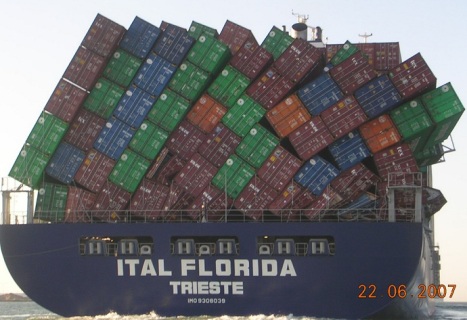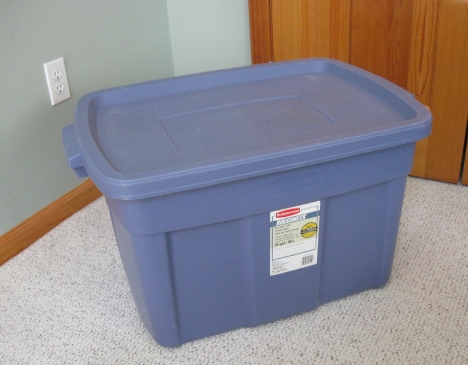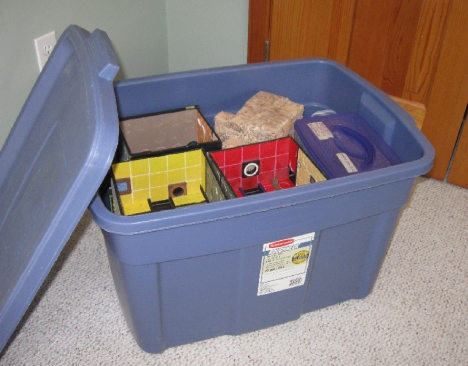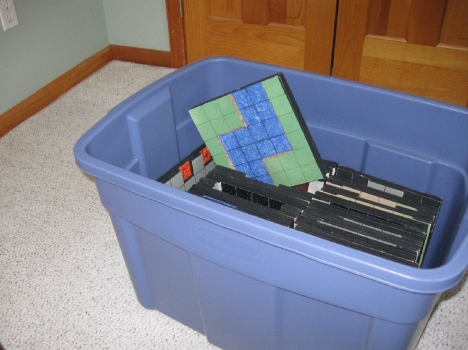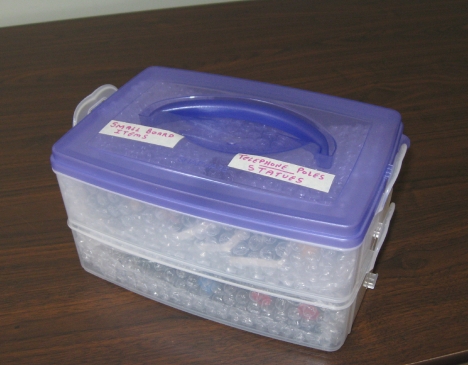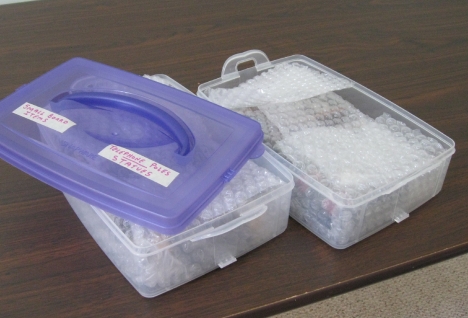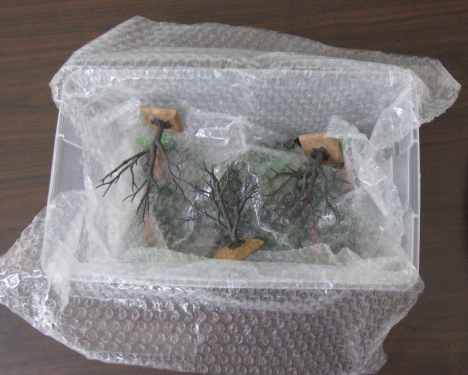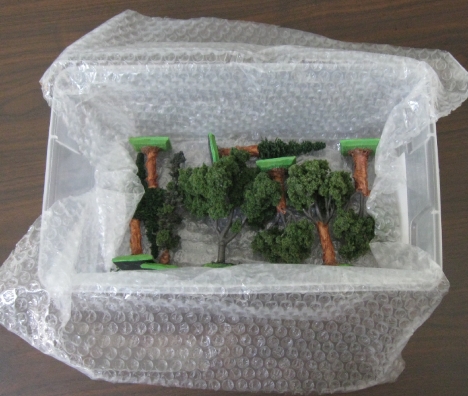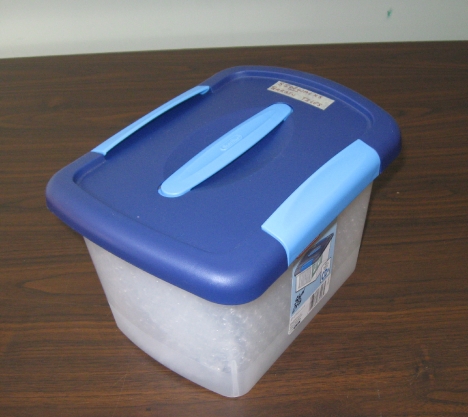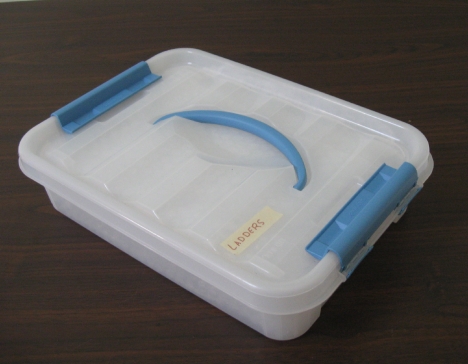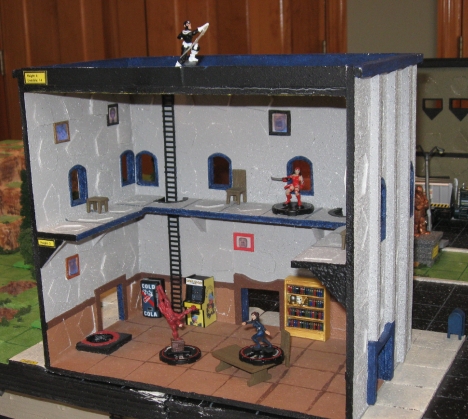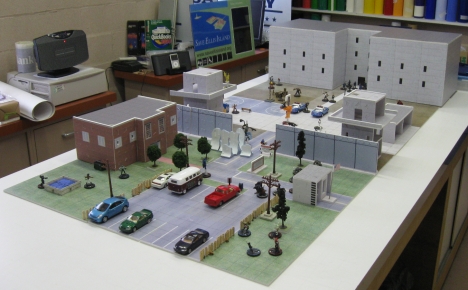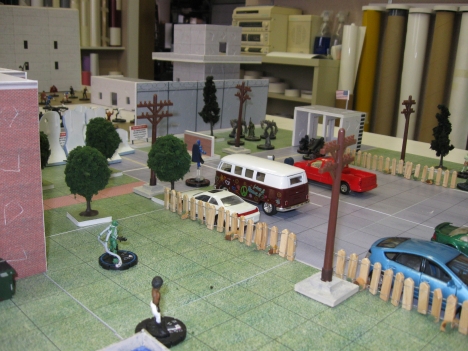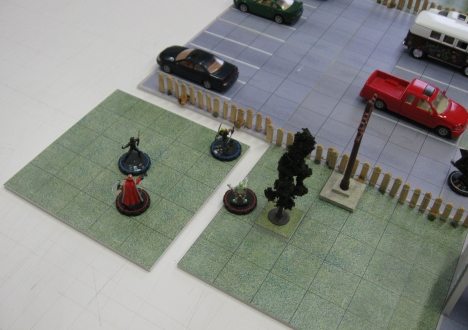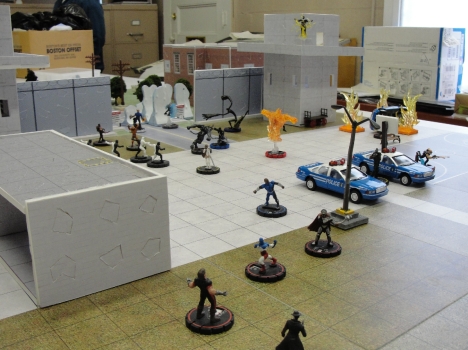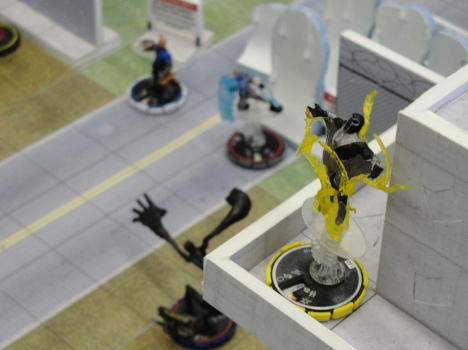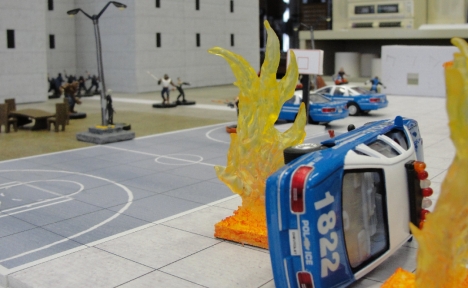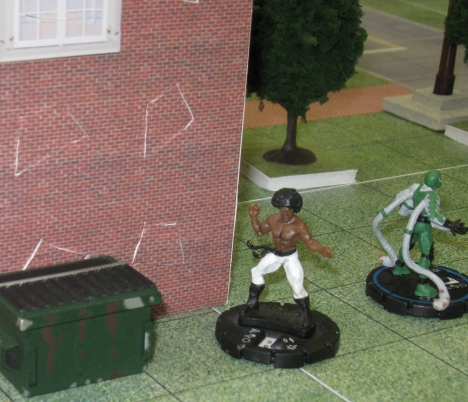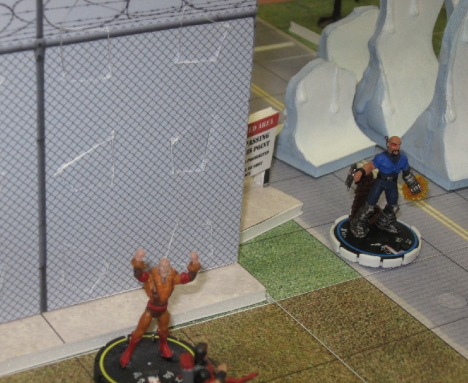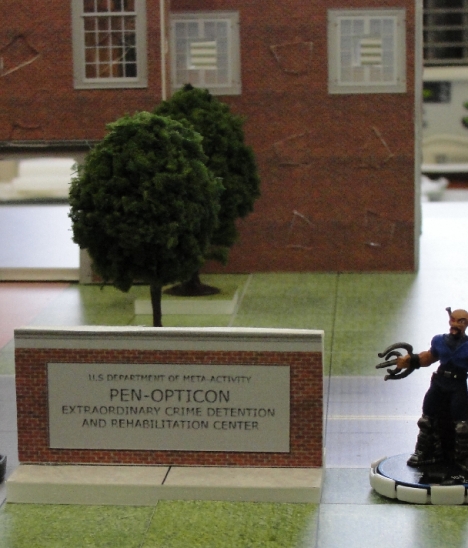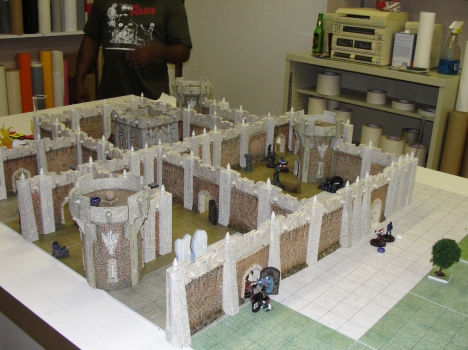 Guy Gardner’s biggest problem with Godzilla trashing New York…? He’s a tourist. If the big G was a hometown boy, then fine, pick an American city, go on a rampage. Totally understandable. But to be a FOREIGN monster and attack U.S. soil…? That is some unacceptable sh*t. Tho, in Godzilla’s defense, the case can be made that he only exists thanks to the radiation dropped by American bombs, meaning that while he IS technically a Japanese monster, the U.S. has to take some responsibility for his…uh…hmmm, I think I’m losing my audience.
Guy Gardner’s biggest problem with Godzilla trashing New York…? He’s a tourist. If the big G was a hometown boy, then fine, pick an American city, go on a rampage. Totally understandable. But to be a FOREIGN monster and attack U.S. soil…? That is some unacceptable sh*t. Tho, in Godzilla’s defense, the case can be made that he only exists thanks to the radiation dropped by American bombs, meaning that while he IS technically a Japanese monster, the U.S. has to take some responsibility for his…uh…hmmm, I think I’m losing my audience.
HeroClix maps! As fun a game as ‘Clix is, the standard paper maps have always been one of the least appealing aspects for me. The more the battlefield looks like something out of a comic book, the more I can lose myself and get into the game. So, after a handful of bouts on traditional HeroClix maps, I went about creating my own. This 3-D customizable board is my most recent and, to get a better look at it, let’s rearrange the map and get a wide shot…
 Eeesh, never a shortage of giant creatures trying to wreck the joint. Giants = jerks.
Eeesh, never a shortage of giant creatures trying to wreck the joint. Giants = jerks.
Let’s get rid Galactus, the Avengers, the buildings, the cars, all that stuff. We’ll come back and cover those objects & obstacles in a bit, but first let’s focus on the base map…
 This shot is identical to the Galactus photo above, just minus all the clutter. But we’re not done moving stuff yet…
This shot is identical to the Galactus photo above, just minus all the clutter. But we’re not done moving stuff yet…
 This big honkin’ map doesn’t exist as a single game board: it’s comprised of smaller game tiles that, when placed end-to-end, create whatever setting you like. Urban jungle, forests, deserts, castles…build an enormous battlefield (like the 42 x 24 movement grid above), all the way down to a 6 x 6 grid if you wanna play in a phone booth.
This big honkin’ map doesn’t exist as a single game board: it’s comprised of smaller game tiles that, when placed end-to-end, create whatever setting you like. Urban jungle, forests, deserts, castles…build an enormous battlefield (like the 42 x 24 movement grid above), all the way down to a 6 x 6 grid if you wanna play in a phone booth.
Let’s take a closer look at one of those tiles…
 “Foam core.” You’ll be hearing a lot about that stuff in this post seeing how so much of the map–including the tiles–are made from it. Each tile is measured out 9″x9″, which translates into six-by-six HeroClix movement squares. Each tile is five sheets of foam core thick, which–in addition to helping make it more resistant to wear and tear–prevents the foam core from curling when coats of glue and paint are applied. Here’s what went into ’em:
“Foam core.” You’ll be hearing a lot about that stuff in this post seeing how so much of the map–including the tiles–are made from it. Each tile is measured out 9″x9″, which translates into six-by-six HeroClix movement squares. Each tile is five sheets of foam core thick, which–in addition to helping make it more resistant to wear and tear–prevents the foam core from curling when coats of glue and paint are applied. Here’s what went into ’em:
First up: cut an assload of 9″ x 9″ foam core squares. When I was a kid, I’d sit in school and see how long I could go without looking at the clock. In theory, the less I’d look, the more quickly time would go by. Except it never worked. I’d wait for what felt like twenty minutes, peek up at the clock and HOW DID ONLY FOUR MINUTES GO BY?!? That’s what cutting these foam squares was like. I needed one hundred and forty of ’em (!) and after cutting what I was sure was a hundred, I count the stack and twenty-eight, twenty-nine, thirty. I had cut thirty of ’em. MADNESS! My only saving grace was that I had recently picked up a foam board cutter, meaning–unlike most of my custom maps–this one wouldn’t be done entirely by x-acto knife. “Logan Series 1500 Foamboard Cutter.” It’s to foam core what lightsabers are to Ponda Babbas.
Next I grabbed a notepad and sketched out what type of tiles I wanted (city streets, plain desert, grass with stream running through it, etc.). I assigned each of those designs a number and, using a pencil, marked a stack of five blank foam core squares with a corresponding number. Each stack of tiles was glued together using a thin layer of Elmer’s Glue, a light weight placed on top of each stack (a piece of scrap foam core between the tiles and the weight) and the pile was left to dry overnight. Use an equal weight for each stack otherwise some tiles will be thicker than others, meaning they won’t line up properly when you’re putting a map together. NOTE: Any tiered layers of a tile–sunken areas for water, a city street, etc.–those were all cut into the top layer(s) of foam core BEFORE gluing the stack together. I’ll cover that more in-depth under specific tiles later on.
A stumbling block in this process: for the most part it worked out okay, but some sheets of foam core shifted when drying; when certain tiles are placed adjacent to other tiles, there’s a gap between them. One way to avoid that would have been to create a frame-like structure out of wood or plastic–like a deep picture frame–that you could place a stack of tiles in. It would have to be a snug fit, something that would prevent the individual sheets from shifting.
When dry, I sealed all the exposed foam edges of the tiles by paintbrushing them with Elmer’s (that’ll protect them from the corrosive properties of some of the paints). Let that dry, then a light coat of speckle spray paint for texture. Again, let that dry thoroughly. Too much moisture will play havoc with the foam core, so–while at times frustrating–take it slow. A base coat of spray paint (based on whatever the final tile will be; green for grass, black for streets, etc.), followed by hand-painted acrylics for fine-tuning.
One more quick thing about these suckers. Just lemme flip over the grass/pond tile pictured above and…
 …TA-DA, we’re in the big city! To offer as many map varieties as possible, each tile is double-sided. That helps cut down on storage space AND offers the unintended bonus of making the search for any one specific tile a roller coaster of frustration. FUN FACT: It’ll always be the last tile you flip over. The universe hates me and I hate it.
…TA-DA, we’re in the big city! To offer as many map varieties as possible, each tile is double-sided. That helps cut down on storage space AND offers the unintended bonus of making the search for any one specific tile a roller coaster of frustration. FUN FACT: It’ll always be the last tile you flip over. The universe hates me and I hate it.
Okay, to help navigate the different elements of this map, I’m gonna break it down to the four main terrain-types. All tiles and game pieces are interchangeable, but for readability (and sanity’s) sake, we’ll take ’em one at a time.
Ready…?
———— DESERT MAP ————
 So which Defender is gonna draw the short straw to rub sunscreen on Namor? “Imperious Rex, you’ve missed the Avenging Son’s undercarriage!”
So which Defender is gonna draw the short straw to rub sunscreen on Namor? “Imperious Rex, you’ve missed the Avenging Son’s undercarriage!”
Echhh…I don’t care how powerful an asset he is to the team, after twenty minutes of hearing him bitch about chaffing *POOF*, I’d slip Doc Strange a fiver to teleport his ass back into the Finger Lakes.
Lets change the setup and zoom in…
 Uh-oh, looks like the Hulk ate shellfish again.
Uh-oh, looks like the Hulk ate shellfish again.
The customizable nature of the map allows any terrain type to be laid out in a variety of ways. A desert map can be a flat, mostly empty wasteland (two pics up) or you can set up a battlefield with full of obstacles like trees, mountains and assorted debris (above).
Anyway, let’s clear the table and get a closer look at the desert tiles…
 My thinking here was to make the color of the sand uniform, give it that “endless desert” look. The result is…a bit boring. These tiles would benefit from having lighter and darker shades of brown blended in.
My thinking here was to make the color of the sand uniform, give it that “endless desert” look. The result is…a bit boring. These tiles would benefit from having lighter and darker shades of brown blended in.
Some variety is offered in surface depressions (right tile above). Before gluing the layers of foam core together, I cut a section from the top sheet to mimic a natural dip in the terrain, making it less uniform, not so man-made. To help sell that natural look, I used an x-acto to angle the edges of that depression to create a short slope leading into sunken area. A right-angle drop would look too man-made, the slope helps the dip look more organic.
A less successful attempt at spicing up the desert tiles was giving them a “windswept” look. I took index cards–glued together two sheets thick with Elmer’s–cut some random, rounded shapes that varied in length from one to three inches and glued them to the desert side of the tiles before applying speckle paint. I thought the result would give the finished product a desert-y look, but they’re barely noticeable. If you double-click the above image and squint, you might catch a glimpse of them on the tile on the right. There could be something to the idea, tho… just the index card shapes would have to be more pronounced, maybe use index cards five or six layers thick.
The movement grid design was added last and came courtesy a Sharpie. Brown for the sand, blue for water, green for the grass, etc.
There’s two types of desert tiles: the “plain” tiles above and this sucker…
 A desert-to-forest blend. One of my goals with this map was to make it so any tiles could work when placed next to one-another. That said, the abrupt color change of a desert tile laid next to a forest tile looked wonky. An easy solution was to make a handful of tiles that transitioned in color from sandy brown to grassy green…
A desert-to-forest blend. One of my goals with this map was to make it so any tiles could work when placed next to one-another. That said, the abrupt color change of a desert tile laid next to a forest tile looked wonky. An easy solution was to make a handful of tiles that transitioned in color from sandy brown to grassy green…
 …see? Desert tiles on the left, grassy tiles on the right and the transition tiles in-between. As in nature, a lush forest setting can always be found roughly fifteen feet from a desert wasteland. The hard science of super heroes trumps reality yet again!
…see? Desert tiles on the left, grassy tiles on the right and the transition tiles in-between. As in nature, a lush forest setting can always be found roughly fifteen feet from a desert wasteland. The hard science of super heroes trumps reality yet again!
To help with the transition theme of these tiles, the grass on these half-and-half map squares are a lighter shade of green than the all-grass tiles.
Two house rules come into play with desert maps. First, figures with the fish speed icon receive a -1 to offense and defense while on an all-desert movement square. Second, ice barriers cannot be placed on all desert movement squares. Suck on THAT, fish and/or ice guys.
Getting back to split maps, a desert/forest combo is nice, but mix in some gray castle tiles (more on those later), add some Mage Knight castle pieces and…
 WHAMMO, a secret Hydra desert fortress just waitin’ to be stormed by super soldiers, Invaders and Howling Commandos! Dibs on holding down Arnim Zola and touching his eyes. Which are on his chest. Which is his face. That is some crazy sh*t.
WHAMMO, a secret Hydra desert fortress just waitin’ to be stormed by super soldiers, Invaders and Howling Commandos! Dibs on holding down Arnim Zola and touching his eyes. Which are on his chest. Which is his face. That is some crazy sh*t.
Let’s take a gander at the items peppering this desert battlefield…
DEAD TREES
 Little-known side-effect of gamma ray exposure: shirt and shoe allergies. Don’t expect any service at the 7-11, boys.
Little-known side-effect of gamma ray exposure: shirt and shoe allergies. Don’t expect any service at the 7-11, boys.
So, dead trees. They’re a bit under 4 1/2″ tall (three movement sections). They, like all non-player/barrier objects, have a defense of zero and can be destroyed (or telekinetically grabbed) by an attack of two or more damage (just avoid snake eyes on your combat roll). Figures with super strength can simply destroy an object as/part of any action OR grab and carry the object to use as a weapon.
Trees have “intact” and “broken” versions. The upright tree to the left of the Hulk is intact. If blasted by a successful attack or uprooted to be used as a weapon, it’s replaced with a log (what the Abomination is holding). It helps the map feel more interactive…almost all the terrain objects have a “battle damaged” substitute. As the game progresses, the map is transformed from a scenic locale into a war zone. Speaking of which, where are the Damage Control HeroClix?
The upright tree is considered blocking terrain. One of our house rules is that when an upright tree is successfully hit, the attacker chooses what direction it falls. It then “attacks” (as a heavy object) whatever occupies the three sections on which it lands. This attack uses the offense of the figure that felled the tree at -1, and any figure in the path of the tree gets a free agility roll to avoid the damage. It’s a sneaky way to attack a Stealth figure hiding in hindering terrain…you’re not targeting that figure, the tree–which doesn’t need line of sight–is.
When destroyed, the tree becomes a log. These are three sections long and considered heavy objects. Logs can be used as hand-to-hand weapons by figures with Super Strength, extending their reach and granting them a “ranged Charge attack.” Make sense…? The Abomination–using Charge–can swat a figure up to three sections away by using the tree as a monster baseball bat.
One last house rule on the trees:
HYBRID HINDERING TERRAIN. When any map object is replaced with a “battle damaged” version of itself, it becomes a piece of hybrid hindering terrain (HHT). Figures with Stealth can hide on/behind them, non-Stealth figures receive a +1 defense for every section of HHT targeted through. Unlike regular hindering terrain, figures without a Stealth or a speed modifier (Leap/Climb, Phasing, Hypersonic, etc.) moving through this terrain only receive a -1 to their movement for every section traveled through.
As for making the trees…
 The trees can be picked up from any number of hobby stores. These were part of a kit that required you to glue the foliage on yourself, so–by not doing that–I got some thirsty looking desert trees. My only problem with them? They kept falling over whenever a player bumped the table, even after I glued them to a foam core base (the trees, not the players). I needed to make the bases heavier, so here’s what I did:
The trees can be picked up from any number of hobby stores. These were part of a kit that required you to glue the foliage on yourself, so–by not doing that–I got some thirsty looking desert trees. My only problem with them? They kept falling over whenever a player bumped the table, even after I glued them to a foam core base (the trees, not the players). I needed to make the bases heavier, so here’s what I did:
Cut squares of foam core 1 1/2″ x 1 1/2″ (the size of a HeroClix movement square), cut a circle out of the center 1 1/4″ in diameter. Glue five index cards together with a thin coat of Elmer’s, let dry, then glue the foam core square onto the index card square with Elmer’s. When dry, drop a thick 1 1/4″ washer into the foam core hole and place the tree–with its small plastic stand–on top of the washer. Use a glue gun to fill the hole with hot glue, covering the washer and the plastic tree base. While the hot glue is drying, stir the surface slightly with a modeling tool to get a rough, more natural look instead of a smooth finish.
The foam core tree base now has a hard vertical edge, which we don’t want. Using an x-acto, cut the edges of the foam square at an angle so the tree base resembles a rounded mound. A light paintbrush of Elmer’s on the exposed foam and, when dry, some hand painted acrylics takes it home. It’s a lot easier than it sounds and does away with the annoyance of constantly-toppling trees.
The “battle damaged” trees–the logs–are simple. Pick up some wood rods from the hardware store and break ’em to whatever size the intact trees are (in this case, 4 1/2″). Paint brush some Elmer’s onto the rod and apply small strips of toilet paper as the bark, throwing in some rolled bits as knots and scars. Let dry, then add small drops of Krazy Glue for the tissue to absorb, essentially turning it into a polymer. Be sure to wear a breathing mask in a ventilated room when you work with any serious amount of Krazy Glue…Krazy Glue allergies can manifest instantly and be terribly unpleasant. For the trunk (“clumped dirt”), some more TP coiled around the base, shaped with a small bit of Elmer’s and once again hardened with Krazy Glue.
In hindsight, I should have made the logs much thicker, like three, four times fatter than what I went with. I went for a thickness that resembled that of the standing trees, but that was a mistake. They seem kinda puny as I have ’em now…they should be bigger, thicker logs that look like they could crush you like a grape.
PICKET FENCE
 I wish people dressed like the Phantom Stranger in everyday life. Cape, fedora, badass disco medallion…the ‘Stranger is one smoooth mutha.
I wish people dressed like the Phantom Stranger in everyday life. Cape, fedora, badass disco medallion…the ‘Stranger is one smoooth mutha.
Picket fence sections are one high, treated as light objects and are hybrid hindering terrain (as detailed in Desert/Dead Trees).
 These are great and I’d love to take credit for making them, but I found ’em while hunting ebay for gaming miniatures. All I did was cut the longer fence strips into smaller sections so it could be “torn up” in battle piece-by-piece.
These are great and I’d love to take credit for making them, but I found ’em while hunting ebay for gaming miniatures. All I did was cut the longer fence strips into smaller sections so it could be “torn up” in battle piece-by-piece.
To make sure these smaller sections would stand, I took 1/4″ x 1/2″ snips of index card paper (glued with Elmer’s two sheets-thick) and shaped them into an “L.” I then Krazy Glued one “L” opposite the other on each side of the fence, hardened the paper with more Krazy Glue and voilà, little kickstand thingies (flat to camera on the right of the above pic). Small bits modeling moss hot glued here and there helped hide the kickstands.
TOMBSTONES
 Spandex Zombie Dance Party!
Spandex Zombie Dance Party!
Those no good JLA ghouls are some customs I whipped up a few years back (more on them here), but let’s zoom in on the tombstones…
 Trees with washer-weighted bases, a picket fence with a kickstand…toppling map items are a pet peeve of mine and these gravestones were the guiltiest of the bunch. I surfed hobby shops until I found tombstones at near-HeroClix scale, trouble is they were never intended to be free-standing objects. They were meant to be glued directly to a game board, something I wanted to avoid in what was supposed to a highly-customizable map. So I took six index cards, added a thin coat of Elmer’s between each, pressed them under a crazy heavy weight and let ’em sit overnight. That gave me a dense, heavy cardboard from which I cut 1″ x 1/2″ strips. A tombstone was attached to each with Krazy Glue, a final touch of neutral acrylics to downplay the base and no more wobbly graveyard. Unless of course some dick runs them over with a motorcycle. Thanks, Ghost Rider. You know what…? Your movie sucked.
Trees with washer-weighted bases, a picket fence with a kickstand…toppling map items are a pet peeve of mine and these gravestones were the guiltiest of the bunch. I surfed hobby shops until I found tombstones at near-HeroClix scale, trouble is they were never intended to be free-standing objects. They were meant to be glued directly to a game board, something I wanted to avoid in what was supposed to a highly-customizable map. So I took six index cards, added a thin coat of Elmer’s between each, pressed them under a crazy heavy weight and let ’em sit overnight. That gave me a dense, heavy cardboard from which I cut 1″ x 1/2″ strips. A tombstone was attached to each with Krazy Glue, a final touch of neutral acrylics to downplay the base and no more wobbly graveyard. Unless of course some dick runs them over with a motorcycle. Thanks, Ghost Rider. You know what…? Your movie sucked.
We treat tombstones as hybrid hindering terrain (detailed under “Desert/Dead Trees”), one-high heavy objects.
MOUNTAIN
 Cowboys & Aliens!
Cowboys & Aliens!
I love the Dominators, they’re so irredeemably evil and terrible, a classic ’50s-style “Conquer the Earth and steal da wimmens!” race of unrepentant dick faces. My two cents: they should be the Skrulls of the DCU, the bad penny alien menace that makes life miserable for the spandex crowd. They blew up Australia once!
Anyway, let’s turn that mountain around and get a better look at things…
 More of that spiffy foam core cut to whatever size you like (just stick to the 1 1/2″ x 1 1/2″ grid), varying levels helps the mountain look less boxy. Each layer of foam core is held together with a thin brush of Elmer’s and left to dry overnight. The edges of the top layers of foam core (at every level) where all cut at an angle for a more natural look–the hard vertical edge looked too man-made.
More of that spiffy foam core cut to whatever size you like (just stick to the 1 1/2″ x 1 1/2″ grid), varying levels helps the mountain look less boxy. Each layer of foam core is held together with a thin brush of Elmer’s and left to dry overnight. The edges of the top layers of foam core (at every level) where all cut at an angle for a more natural look–the hard vertical edge looked too man-made.
Speckle paint alone wouldn’t cut it here for texture, so out came the hot glue gun. Lemme zoom in and point out an example of hot glue texturing…
 …oh, hey, thanks Skrull Infiltrator. That’s very helpful. You Skrulls get a bad rap.
…oh, hey, thanks Skrull Infiltrator. That’s very helpful. You Skrulls get a bad rap.
I used the glue gun to apply a blob of hot glue on the mountain face and–using a modeling tool–smeared the glue to crate a thin layer of craggy “stone.” Hot glue dries quick when you spread it thin, so work in small patches until the entire mountain face is covered. Don’t sweat this process at all; there’s almost no way to do it wrong. Messy = “looks like nature!”
Dark brown acrylics were added as a base color followed by sloppy layers of gradually lighter brows unevenly applied for that non-uniform, natural look. When dry, patches of modeling moss were attached with hot glue. One final touch was an added to help ease of gameplay…
 …alright, enough with the sucking up, Skrull Infiltrator. I’m NOT modding you a girlfriend.
…alright, enough with the sucking up, Skrull Infiltrator. I’m NOT modding you a girlfriend.
Anyway, the final touch is something I try and do with all my map mods: make it user-friendly. I printed out small labels–a quarter inch long, half that wide–and attached them to each of the varying heights of the mountain to indicate height. “+1 Height” for the first level, “+2 Height” for the next, etc. FUN FACT: It doesn’t stop players from asking “How tall is this…?” in every game.
House rule for climbing mountains, buildings, any elevated terrain: figures with flying, leap/climb, phasing or hypersonic can move between levels, no problem (tho non-flyers have to count upward movement as part of their overall movement total). Figures without any of those speed modifiers can still scale vertical structures, they just do so at 50% speed.
One last quick bit about the mountain…

I swapped out the desert tiles for some forest/water terrain to better spotlight the cave/tunnel. See, when used on dry land, the tunnel in the center of the mountain provides a shortcut for figures to run through and surprise opponents on the other side. But–as displayed above–the tunnel was sized to match the width of the stream, allowing the mountain to be used as a natural bridge over the water.
So that’s a wrap for the desert. Let’s flip over these sandy tiles and see what other maps we can make…
———— FOREST MAP ————
 Ahhh, much prettier than the desert wasteland map. Well, except for the genocidal mutant flame bird trying to murder her teammates. Such a downer. Let’s switch to a different scene, maybe something further north…
Ahhh, much prettier than the desert wasteland map. Well, except for the genocidal mutant flame bird trying to murder her teammates. Such a downer. Let’s switch to a different scene, maybe something further north…
 Now we’re talking: ’80s permed hair, cannibalizes campers, has a boss tail…Canadian Bigfoot kicks ass all over American Bigfoot.
Now we’re talking: ’80s permed hair, cannibalizes campers, has a boss tail…Canadian Bigfoot kicks ass all over American Bigfoot.
 Grass tiles are almost identical in their creation to the desert tiles, though I skipped the ill-fated “windswept” stage.
Grass tiles are almost identical in their creation to the desert tiles, though I skipped the ill-fated “windswept” stage.
After a light coat of speckle spray paint for texture, I used three different shades of green spray paint for the grass. First up was an uneven spotting of dark green, followed by an uneven (though more thorough) coat of a grass green. A final, sparse hit here and there of light green and we have a good, blended finish.
Like the desert tiles, some grass tiles have depressions–uneven surface terrain–to help break up the look, make it feel less like a flat map and something more natural. That idea was taken a step further with grass/water forest tiles…
 AGUA! The water sections of the tiles line up when tiles are placed side-by-side. If you’re adding a stream to your map, you can make it wind across the battlefield in any shape or size…
AGUA! The water sections of the tiles line up when tiles are placed side-by-side. If you’re adding a stream to your map, you can make it wind across the battlefield in any shape or size…
 …though some tiles (above left) feature self-contained water terrain in case a small pond is what you’re looking for.
…though some tiles (above left) feature self-contained water terrain in case a small pond is what you’re looking for.
I toyed with the idea of making tiles with larger expanses of water, even all-water tiles so you could make river/ocean maps. Trick is, from my experience those maps are cooler in theory than application. The first HeroClix map I built had some extensive water tiles, and those were rarely used. Most ‘Clix figures aren’t water-based characters, so the more popular maps were those with limited water terrain.
Water terrain is one layer of foam core lower than standard terrain. To achieve that, the single sheet of foam core destined to be the grass/water layer of this tile was cut BEFORE the five sheets of foam core were glued together into the tile. To help with the natural look, the edge of the grass leading into the water was cut at an angled slope–an abrupt vertical cut looks man-made.
After the tile was assembled and painted, the water was formed by squeezing hot glue onto an area and–while still warm–spreading/smearing it around as if you were frosting a cake. Hot glue dries fast when it’s spread out like that, so I did one small area at a time. When dry, a thorough base coat of blue was followed by a light,uneven dry brushing of light blue. The angled edges of the map leading to the water were painted as soil; varying shades of brown to help sell the overall aesthetic. The water movement grid was added last with a Sharpie (blue for water, green for grass).
Something that flies in the face of that aesthetic…? The ninety-degree corners that form the water. On previous maps I made the water follow a more natural, rounded shape that resulted in movement squares being comprised of both land and water terrain. That looks better and works rules-wise (figures on/adjacent to those squares can treat them as either solid ground or water), but it led to an unforeseen problem: with the water being one sheet of foam core lower than the land terrain, flight stands could not balance on that uneven movement square. In the battle between ease-of-gameplay and a more natural looking body of water, gameplay won out. Eat it, rounded corners.
Couple of quick house rules our group uses for water: a figure with a fish symbol may move twice as fast in water as they can on land (EX: a fish symbol guy can move ten sections in water if his speed is a five). A non-fishie moving into water terrain must immediately stop all movement, they exit the water at 50% and may not make long-range attacks while in water (tho non-fishies with a speed modifier like Phasing or Hypersonic Speed ignore those penalties).
Taking a cue from water being one sheet of foam core lower than the rest of the map, some tiles feature terrain that goes even deeper with their layers…
 The sewer pipe and sand pit. While water only goes one layer deep, these suckers dig four sheets of foam core into the map. It’s tough to see that in an aerial view, so let’s tilt the angle and get some figures in the shot…
The sewer pipe and sand pit. While water only goes one layer deep, these suckers dig four sheets of foam core into the map. It’s tough to see that in an aerial view, so let’s tilt the angle and get some figures in the shot…
 …there we go, Vermin lurking near the discharge pipe on the sewer tile. Echh, ten bucks says his pants can stand up on their own.
…there we go, Vermin lurking near the discharge pipe on the sewer tile. Echh, ten bucks says his pants can stand up on their own.
The elevated grass and the sewer goop are all the same map tile. The small section of grass that Vermin is standing on is three sheets of foam core deep, while the sewage discharge pit is four sheets deep.
Tiles like this help offer some variety to map-making, but they affect gameplay as well. Figures in a pit receive a +1 defense when targeted by those on the surface (almost like the figures in the pit were in a fox hole). Unless a figure has Stealth, Flight or a speed modifier (Leap/Climb, Hypersonic, Phasing, etc.), moving into or out of a pit delivers a -1 speed penalty. As for what kind of terrain the sludge is, that’s up to the players. We usually play that if a figure lands in it, they need to roll a breakaway to escape (figures with Phasing and Hypersonic being immune).
The sides of the pit are sculpted hot glue, identical to the procedure outlined in the Desert/Mountain section. The sewage discharge follows the steps covered in the forest/water tile with a few minor tweaks. It’s still hot glue, though instead of using a modeling tool to whip the surface texture, I let the hot glue cool as a near-smooth surface. When solid, I drip random gobs of hot glue on the surface and let them dry as rounded blobs, making that “bubbling” surface effect. That’s followed by an uneven splatter of dark brown acrylics followed by a slightly more even coat of brown, then finished with some splashes of varying browns to break things up.
TREES
 Ted Sallis, World Hide n’ Seek Champ: 1971-Present.
Ted Sallis, World Hide n’ Seek Champ: 1971-Present.
Speaking of Man-Thing, I always thought he was a Swamp Thing knockoff, but apparently things are a bit more gray. Check out the “Publication History” detailed here.
Back to the foliage: no heavy lifting modding, you can pick miniature trees up at any number of hobby stores or online retailers.
 These are identical to the trees covered in the Desert/Dead Trees section, they’ve just had modeling moss glued to the branches. The directions called for the moss to be attached with spray adhesive, but I couldn’t get that to work to save my life. After a few attempts that made everything in the room sticky EXCEPT the trees, I went with hot glue. Time consuming, but eh, AMC was running a “Walking Dead” marathon. Time flew.
These are identical to the trees covered in the Desert/Dead Trees section, they’ve just had modeling moss glued to the branches. The directions called for the moss to be attached with spray adhesive, but I couldn’t get that to work to save my life. After a few attempts that made everything in the room sticky EXCEPT the trees, I went with hot glue. Time consuming, but eh, AMC was running a “Walking Dead” marathon. Time flew.
One quick thing about these buggers…
 The pack of trees I was working with came in several different heights. Trick is–for ease of game play–I wanted a uniform height to avoid targeting disputes. To beef up the height of the shorter trees, here’s what I did:
The pack of trees I was working with came in several different heights. Trick is–for ease of game play–I wanted a uniform height to avoid targeting disputes. To beef up the height of the shorter trees, here’s what I did:
Grab a 1 1/2″ x 1″ sheet of index card paper glued three sheets-thick and roll it into a tight tube, add a few drips of Krazy Glue at the seem to hold the shape. When dry, insert one end into the foam core tree base and hold in place with hot glue (as detailed in the Desert/Dead Tree section).
When dry, slide the plastic tree into the top of the index card tube and use small strips of index card paper two sheets-thick to anchor it in place. You can see what I mean by that in the above pic: see how three branches are sprouting out of the core tree structure? And how there’s a section of brown between the second and third branch…? That’s the index card strap and will help hold the tree in the index card tube. Use a few drips of Krazy Glue to secure that “strap” in place.
When dry, stuff small bits of rolled up TP into the top of the tube to fill any empty space, add a few drips of Krazy Glue to harden and let dry.
When that’s all secure, give the index card tube the “log texture” treatment as detailed under Desert/Dead Tree, paint, add moss and you’re good to go.
HINDERING TERRAIN
 “You know that Canadian mutant, the crazy one with the big f*cking knives sticking out the back of his hands…? Yeah, we kidnapped his friends and now he’s running around all pissed off in the backyard. Put on this sight-restricting, sound-muffling mask and go see if you can find him. Good luck.”
“You know that Canadian mutant, the crazy one with the big f*cking knives sticking out the back of his hands…? Yeah, we kidnapped his friends and now he’s running around all pissed off in the backyard. Put on this sight-restricting, sound-muffling mask and go see if you can find him. Good luck.”
Bye, Hellfire goons.
 I’ve been wrestling with a way to make hindering terrain since my first custom map. I’ve tried darker movement squares, sunken squares, nothing has ever looked right. This is my third time at bat and I’m still kind of “meh” on the finished product.
I’ve been wrestling with a way to make hindering terrain since my first custom map. I’ve tried darker movement squares, sunken squares, nothing has ever looked right. This is my third time at bat and I’m still kind of “meh” on the finished product.
Working with index cards Elmer’d five sheets thick, I cut strips three inches long and one inch high. I then cut some random holes in the side and trimmed a wavy finish along one of the 3″ edges. Using a thick paintbrush handle, I put a bend lengthwise in the strip, giving me an rounded L-shaped piece of index card 1″ high with two catty-cornered edges running 1 1/2″.
I then cut a hard “L” shape out of that same five-sheet thick index card, I 1/2″ long in both directions and 1″ wide. I Krazy Glue’d the original piece of index card (wavey side up) onto this “L” shape, hit it with some varying shades of acrylic green, hot glued some actual tree branches and modeling moss and…well, that’s about it. Figures fit in/on it like so…
 The open L-shaped base allows pretty much any figure to stand in it, even fatties like Egg-Fu or figs with double-wides like Lockjaw. If a flight stand lands on a piece of hindering terrain, just lift the hindering, place the flight stand on the map square and then place the hindering back on top of the flight stand base. Easy.
The open L-shaped base allows pretty much any figure to stand in it, even fatties like Egg-Fu or figs with double-wides like Lockjaw. If a flight stand lands on a piece of hindering terrain, just lift the hindering, place the flight stand on the map square and then place the hindering back on top of the flight stand base. Easy.
They work okay, but I still think there’s gotta be a better looking way to indicate hindering terrain. It’s my white whale.
ROCK WALL
 B.P.R.D., the Ghostbusters, Kolchak…it doesn’t matter which: being a monster hunter sounds like the best job ever. I’ve wanted that gig since I was six.
B.P.R.D., the Ghostbusters, Kolchak…it doesn’t matter which: being a monster hunter sounds like the best job ever. I’ve wanted that gig since I was six.
Anyway, rock wall sections are considered one high heavy objects and are treated as the hybrid hindering terrain outlined in the “Desert/Dead Tree” section.
 I found these suckers while surfing hobby stores. The pieces were originally six inches long, which were a tad unwieldy for my needs. I wanted them available to players as smaller sections that could either by blasted apart bit-by-bit OR used as a weapon via Telekinesis or Super Strength. Simple fix: I sawed them in half, rebuilt the edges using toilet paper shaped with Elmer’s and–when I was happy with the look–hardened ’em with Krazy Glue. Some gray and black acrylics and the walls were a more manageable size.
I found these suckers while surfing hobby stores. The pieces were originally six inches long, which were a tad unwieldy for my needs. I wanted them available to players as smaller sections that could either by blasted apart bit-by-bit OR used as a weapon via Telekinesis or Super Strength. Simple fix: I sawed them in half, rebuilt the edges using toilet paper shaped with Elmer’s and–when I was happy with the look–hardened ’em with Krazy Glue. Some gray and black acrylics and the walls were a more manageable size.
WOODEN BRIDGE
 Water terrain is nice and all, but they’re potentially frustrating to players using figures without flying, a fish symbol or a speed modifier. To help those characters navigate these natural barriers, we have a couple of bridges to choose from. The wooden bridge is…wait, looks like Gorilla Grodd is headed to the jungle pharmacy to pick up his IBS medication.
Water terrain is nice and all, but they’re potentially frustrating to players using figures without flying, a fish symbol or a speed modifier. To help those characters navigate these natural barriers, we have a couple of bridges to choose from. The wooden bridge is…wait, looks like Gorilla Grodd is headed to the jungle pharmacy to pick up his IBS medication.
Do it to it, Flash…
 …ha, JUSTICE!
…ha, JUSTICE!
Hope you can swim, monkey.
Let’s take a closer look at that bridge…
 The bridge and bridge debris are separate pieces; the bridge itself doesn’t snap apart. I thought about building it that way, but common sense won out. Making it as one break-apart piece would have been a ton of extra work for no real in-game benefit.
The bridge and bridge debris are separate pieces; the bridge itself doesn’t snap apart. I thought about building it that way, but common sense won out. Making it as one break-apart piece would have been a ton of extra work for no real in-game benefit.
Bridge base is a piece of foam core, cut 3 1/4 “x3″ (that extra 1/4” helps the bridge…ah, “bridge” the water). The “planks” are strips of index cards glued with Elmer’s three sheets-thick and cut into strips of varying width (around 1/4″) and about 3 1/4″ long (I wanted the planks to hang off the edge of the base foam core). Using an x-acto, each plank was given an uneven, broken look at the end. To help give the index card a rough-hewn finish, I dragged the x-acto up and down each plank–applying slight pressure–to cut grooves into the surface. A few knotholes cut here and there and they were ready to be Elmer’d to the base foam core.
Once that was dry, a light coat of watery dark brown paint was applied and sucked into the various cracks (don’t use too much or you’ll warp the paper). Let dry, then a light brushing with a tannish-brown for a final coat. Same steps were followed for the bridge debris.
My group originally treated the bridge as a massive object (+3 damage as a handheld, +4 as a missile w/ auto knockback). That made it too desirable a weapon, tho; the bridge is an important part of the map, so we changed it that it can’t be picked up as a single piece by Telekinesis or Super Strength (thematically, it’s too “structurally unsound” and breaks apart when you try and lift it). It can still be broken by an attack or simply smashed by a guy with Super Strength.
Wood bridge sections are considered light objects and are hybrid hindering terrain (as detailed under Desert/Dead Trees).
We ended the desert map section with Mage Knight castle pieces added to the mix, so let’s give that another go. Only this time, let’s do it with forest tiles…
 BAM!, the siege of Asgard is on, bitches! What are the odds that Odin is sleeping through this? (SPOILER: 100%)
BAM!, the siege of Asgard is on, bitches! What are the odds that Odin is sleeping through this? (SPOILER: 100%)
Enough with the castle teases, let’s flip the green forest tiles upside-down and put some gray in the spotlight…
———— CASTLE MAP ————
 “Castle Doom.” Second only to the Batcave for coolest sounding comic book lair ever. FUN FACT: The Joker’s “Ha-Ha-Hacienda” comes in at #782.
“Castle Doom.” Second only to the Batcave for coolest sounding comic book lair ever. FUN FACT: The Joker’s “Ha-Ha-Hacienda” comes in at #782.
Okay, let’s rearrange the tiles, add some clutter and zoom in on a castle layout…
 The castle walls and towers all come courtesy of Mage Knight castle packs, while the the assorted clutter (fountains, bookshelves) are items we’ll get to in a bit.
The castle walls and towers all come courtesy of Mage Knight castle packs, while the the assorted clutter (fountains, bookshelves) are items we’ll get to in a bit.
First up, the castle floor map tiles…
 Same ingredients as the other tiles we’ve covered, though after the speckle texture step, these were finished with a matte gray spray paint followed by a light, uneven pass of black to help break up the uniform color.
Same ingredients as the other tiles we’ve covered, though after the speckle texture step, these were finished with a matte gray spray paint followed by a light, uneven pass of black to help break up the uniform color.
While forest and desert maps have the luxury of terrain extras like trees and fences, castle interiors tend to challenge trespassers with catwalks and bottomless pits, elements that I decided to build directly into the tiles…
 Similar to the sewer pipe we covered in the Forest section, a healthy handful of the castle tiles feature deep pits that have been cut into the surface of the foam core. The tile above features small lava pits built directly into this piece of the map (three sheets of foam core deep) . The bubbling lava is hot glue and follows the same steps as outlined under that same Forest/Sewer Pipe section, though the lava was painted with different color acrylics: yellow as a base followed by a dry brushing of orange and finished with an uneven dry brush of red.
Similar to the sewer pipe we covered in the Forest section, a healthy handful of the castle tiles feature deep pits that have been cut into the surface of the foam core. The tile above features small lava pits built directly into this piece of the map (three sheets of foam core deep) . The bubbling lava is hot glue and follows the same steps as outlined under that same Forest/Sewer Pipe section, though the lava was painted with different color acrylics: yellow as a base followed by a dry brushing of orange and finished with an uneven dry brush of red.
The end product is okay, though it’s not very versatile: it’s a lava pit tile. The end. I wanted some castle interior tiles with more customizable potential…
 The black areas of the above tiles are pits four sheets of foam core deep.
The black areas of the above tiles are pits four sheets of foam core deep.
Let’s get an angled shot of one of these suckers to better convey depth…
 The gray bridge that Master Chief is standing on is part of the same tile that the Brood Queen (back to camera) is flying over, though the black “pits” are four layers of foam core deeper than the gray areas. The gray sections of the tile represent standard HeroClix terrain, this time around taking the form of a stone floor. The black portions of the tiles represent empty space; a pit hazard for figures to avoid.
The gray bridge that Master Chief is standing on is part of the same tile that the Brood Queen (back to camera) is flying over, though the black “pits” are four layers of foam core deeper than the gray areas. The gray sections of the tile represent standard HeroClix terrain, this time around taking the form of a stone floor. The black portions of the tiles represent empty space; a pit hazard for figures to avoid.
We’ll get to the game mechanics of those pits in a second. A quick note about making these tiles: when gluing sections together, an extra step was needed in the drying process. Instead of simply putting a scrap sheet of foam core on top of the tile and then adding a weight, I placed small stacks of foam core scrap in the pit areas at a height that was level with the rest of the tile. That helped distribute the weight of the drying process more evenly.
Back to the gameplay of the black pits: Figures with flying can pass over the pits without worry while Leap/Climb guys can hang off the side without breaking a sweat. Figures without some type of movement bonus that are knocked over the edge fall into the darkness. So…what happens when figures take that trip? We’ve played it a couple of different ways. One house rule has it that the player who falls rolls a six-sider. The falling figure is dealt that much damage and it takes that many turns to climb back to the surface (any edge of the pit). Another variant sees a figure–SPLAT!–get handed a simple KO when they go over the side. In both of those instances we have a “saving throw;” the figure in question gets to roll 1d6. On 1-5 they go south, but on a six they manage to grab hold of the ledge and avoid the Wile E. Coyote impression.
While empty black pits on the map are neat, no self-respecting supervillain doesn’t occasionally drown, roast and/or slather intruders in toxic waste. The black “empty” areas of the castle tiles can be filled with three hazardous comic book staples…
FIRE, WATER & SLIME MINI-TILES
 3″ x 3″ terrain tiles. We’ll get to the ingredients in a second, but first let’s see how they work…
3″ x 3″ terrain tiles. We’ll get to the ingredients in a second, but first let’s see how they work…
 A map tile with black “pits.” If you want, leave as-is and the blackness represents a pit obstacle that figures need to avoid. But what if you want a map hazard with a bit more personality…?
A map tile with black “pits.” If you want, leave as-is and the blackness represents a pit obstacle that figures need to avoid. But what if you want a map hazard with a bit more personality…?
 This is the same castle tile as pictured above, I’ve just grabbed a handful of the smaller terrain tiles (in this case, bubbling slime), and dropped them into the black “pit” areas. Now, instead of the quick, clean death of falling off a ledge, figures are slowly drowned in a viscous mucus that fills their lungs and smothers them over the course of several hours. SUCCESS!
This is the same castle tile as pictured above, I’ve just grabbed a handful of the smaller terrain tiles (in this case, bubbling slime), and dropped them into the black “pit” areas. Now, instead of the quick, clean death of falling off a ledge, figures are slowly drowned in a viscous mucus that fills their lungs and smothers them over the course of several hours. SUCCESS!
All the black “pits” of the castle tiles follow 3″ x 3″ measurements (the equivalent of two HeroClix movement spaces). This allows any shape pit–no matter if they’re 3″ x 3″, 6″ x 3″ or whatever–to be filled with one or more of these interchangeable terrain tiles.
So, the mini tiles: foam core, one sheet thick, cut 3″ x 3″. Actually, that’s not right. The squares are 1/8″ shy of three inches both in length and width. That allows them to be easily dropped into (and removed) from any pits. There’s also nothing stopping you from laying the tiles down directly on any flat surface of the map, but they were designed (and look way cooler) when placed in the depressed areas of the board.
Texture effects for the water and fire tiles are identical to the steps outlined in the Forest/Water Tile section, though fire tiles are finished with a base of yellow followed by an uneven brushing of orange and a light dry brush of red. Slime tiles follow the Forest/Sewer Pipe Tile outline but with darker-to-lighter shades of aqua-marine instead of brown. Unlike the larger map tiles, these suckers are one sheet of foam core thick. While small, these mini tiles are wide enough so I wasn’t too worried about warping. Still, I was careful when applying glue and paint–get foam core too wet and it starts curling.
I also kept these mini tiles–unlike the map tiles–one sided. Putting textures on both sides made them too thick and–when placed in a pit–took away the difference in map depth that I was looking for.
So okay, let’s spice up a gray & black castle layout by adding…
 The Fire Pits of Apokalips! Pity the parademon who forgets the graham crackers on s’mores night.
The Fire Pits of Apokalips! Pity the parademon who forgets the graham crackers on s’mores night.
We’ve used a few different house rules for the fire terrain, but the most popular with our group works this way: a figure knocked into a square of fire (knockback, telekinesis, etc.) is dealt 1d6 damage. Defense modifiers like Toughness and Invulnerability help ease that pain while figures with Phasing and Hypsersonic Speed can ignore the damage effect. Figures with the fish symbol have no defense against the damage effects of fire terrain regardless of stat modifiers.
A figure moving into fire terrain has their movement come to a stop and they’re dealt 1d6 damage (same deal as above regarding Toughness, Phasing, etc.). Exiting fire terrain onto non-fire terrain cuts a figure’s speed by 50%.
Fire-based characters (Human Torch, Heatwave, Liz Sherman, etc.) can ignore effects of fire terrain.
Fire insurance too high on your castle? Replace the flaming terrain with some bubbling, goopy slime to recreate…
 The Lazarus Pit! Bath time at Ra’s al Ghul’s house is always such a production.
The Lazarus Pit! Bath time at Ra’s al Ghul’s house is always such a production.
Most popular house rule with my group is that if a figure lands in the slime, they must roll a breakaway to escape. Landing in slime also means that figure receives a 1d6 countdown die that–when it hits zero–indicates the character has been dragged under by the sticky goop and they’re KO’d. Figures with Phasing, Hypersonic, Flying, Super Strength or the fish movement icon may ignore all slime terrain effects.
Not keen with filling your castle with fire and slime? You’re in luck! Just lay in some H2O tiles for…
 “This isn’t water, it’s AL-CO-HOL!” Whoa, keep it down, Namor. If Iron Man hears you we’ll never get him out of the pool.
“This isn’t water, it’s AL-CO-HOL!” Whoa, keep it down, Namor. If Iron Man hears you we’ll never get him out of the pool.
Water tiles have the same properties as outlined in the Forest/Water Tiles section.
DECORATIVE MINI-TILES
 These follow the same measurements as the water, fire & slime tiles: 1/8″ shy length & width of 3″ x 3″. Unlike most of this custom map, the assorted pentagram illustrations above aren’t hand-made. Those came courtesy a pentagram GIS: the white Aztec-looking design, the green Sci-fi teleporter pad, the black mathematical looking thing and the traditional fiery orange pentagram.
These follow the same measurements as the water, fire & slime tiles: 1/8″ shy length & width of 3″ x 3″. Unlike most of this custom map, the assorted pentagram illustrations above aren’t hand-made. Those came courtesy a pentagram GIS: the white Aztec-looking design, the green Sci-fi teleporter pad, the black mathematical looking thing and the traditional fiery orange pentagram.
The pics were adjusted to size (slightly smaller than 3″ diameter), printed on adhesive paper and traced on to the foam tiles. Cover the circular outline with masking tape, seal the exposed foam edges of the tiles with Elmer’s and hit ’em with speckle spray paint. Let that dry, then a coat of matte gray spray paint. When that was dry, remove the masking tape, peel the pentagrams, slap ’em on the foam core squares and we’re off to the races. I debated whether or not to draw movement lines over the designs. I decided not to, but each tile is a two-by-two movement squares (keep an eye on the shiftier members of your gaming group).
These work as simple decorations or they can have a specific in-game function: a spawning point for figures, a gateway that jumps players to other areas of the map, whatever you want. And these–unlike the fire, water and slime mini tiles–are flat, meaning they could be two sided. Let’s give ’em a quick flip and see what’s lurking on the B-side…
 Okay…we’ve got an explosive residue so you can re-enact Alpha Flight #12, a blank square for those of you who like plain pizza, a chalk outline that Batman can check for clues and a trapdoor for Borat’s brother.
Okay…we’ve got an explosive residue so you can re-enact Alpha Flight #12, a blank square for those of you who like plain pizza, a chalk outline that Batman can check for clues and a trapdoor for Borat’s brother.
This side of the tiles follow the same speckle paint/spray paint routine, though the final design elements are hand painted acrylics. Well, all except the trapdoor. That started out as a piece of index card cut to size (2 3/4″ x 2 3/4″) and painted black–that would act as the base. Another 2 3/4″ x 2 3/4″ piece of index card (three sheets thick, glued together by Elmer’s) had bars cut into it vie x-acto and was painted metallic acrylic silver. When dry, the silver bars were glued to the black base and then the base glued to the foam core square (all Elmer’s). You can totally get away with a photo of a trap door, I just like the texture of having “real” steel bars.
These buggers can fit into any pre-cut depression or be laid flat on the board, whatever works best for the map you’re designing…
 Another use for these tiles: prisons. Say Etrigan and Doc Fate are on the same team, but Etrigan–trapped on the summoning tile–is considered out of play until the tile is destroyed and he’s set free. Assign the tile a defense (18 Impervious, indicate amount of “clicks” with a six-sider). Not until freed by one of his teammates can Etrigan take an action. Mix it up: add an eight-sided die that counts down every round. If it hits zero and Etrigan hasn’t been freed, the eight-sided die resets (not the damage die) and Etrigan is swapped out for a figure belonging to the opposing team (say, Felix Faust). Now those who were trying to destroy the summoning tile are trying to protect it while its former guardians seek its destruction. Meanwhile the countdown die ticks away…
Another use for these tiles: prisons. Say Etrigan and Doc Fate are on the same team, but Etrigan–trapped on the summoning tile–is considered out of play until the tile is destroyed and he’s set free. Assign the tile a defense (18 Impervious, indicate amount of “clicks” with a six-sider). Not until freed by one of his teammates can Etrigan take an action. Mix it up: add an eight-sided die that counts down every round. If it hits zero and Etrigan hasn’t been freed, the eight-sided die resets (not the damage die) and Etrigan is swapped out for a figure belonging to the opposing team (say, Felix Faust). Now those who were trying to destroy the summoning tile are trying to protect it while its former guardians seek its destruction. Meanwhile the countdown die ticks away…
SIDEBAR: The one-time D&D player in me has the most fun in setting up castle maps. Dungeon walls, slime pits, the random background items like bookshelves, tables and crates, it all makes me want to do swap out the spandex crowd in favor of some Drow and a couple of mind flayers.
Back to the tiles: let’s see how they look when laid flat on the map instead of in a depression…
 The tiles–like the teleporter pad above–fit in seamlessly on city maps, deserts, forests, pretty much any…wow. The Badoon sure do make a mess when they sleep over. Good luck getting your deposit back on the Earth, jerks. Give ’em hell, Guardians.
The tiles–like the teleporter pad above–fit in seamlessly on city maps, deserts, forests, pretty much any…wow. The Badoon sure do make a mess when they sleep over. Good luck getting your deposit back on the Earth, jerks. Give ’em hell, Guardians.
We’ll get to the city map in just a bit, just a few more things about the castle setting…
TABLES, CHAIRS & MISC.

The background castle shots are littered with extras culled from Mage Knight and HeroClix accessory packs that WizKids released years ago. The maps work fine without them, but I think they look a whole lot better with ’em. As long as something doesn’t interfere with the game mechanics, I’m all for snazzing up the game with little extras. That Conan figure is a custom…more on him here.
Speaking of which, some more custom odds and ends…
METAL BRIDGE
 Okay Cyclops, here’s your big chance to impress Jean: All you have to do is time this right, wait for the Juggernaut to get in the middle of the bridge, zap it with your optic blasts and he’ll sink like a–NO, WAIT, NOT YET…!
Okay Cyclops, here’s your big chance to impress Jean: All you have to do is time this right, wait for the Juggernaut to get in the middle of the bridge, zap it with your optic blasts and he’ll sink like a–NO, WAIT, NOT YET…!
 …aw, man, Colossus didn’t even see it coming.
…aw, man, Colossus didn’t even see it coming.
Ah well. That’s what he gets for being Russian.
 More foam core. The base is 3 1/4″ x 3″ (the extra 1/4″ helps it straddle gaps) with the on/off ends of the bridge cut at an angle for aesthetics. The vertical bridge sides are 3″ x 3/4″.
More foam core. The base is 3 1/4″ x 3″ (the extra 1/4″ helps it straddle gaps) with the on/off ends of the bridge cut at an angle for aesthetics. The vertical bridge sides are 3″ x 3/4″.
Long strips were cut from index card paper glued three sheets thick (Elmer’s) and glued (more Elmer’s) to the bridge as design elements (stripes on the floor and walls), but they weren’t enough. I wanted this to be a sturdy looking brute of a bridge, something you’d find in the Red Skull’s rumpus room. The rounded bolts were snipped from some MechWarrior miniatures (the same half dozen Mechs–the only ones I own–that I’ve been slowly cannibalizing for years).
When that was all combined, a brushing of Elmer’s to coat the exposed foam edges, let dry, then a coat of metallic copper acrylics. Let that dry, then a light wash of matte black acrylics and that was that. The bits of bridge debris were all created with the same ingredients.
Like the bridge covered in the Forest/Wooden Bridge section, the metal bridge cannot be lifted as a single object, though it can be destroyed. Bridge debris are considered light objects and treated as hybrid hindering terrain (as detailed in Desert/Dead Trees).
FOUNTAIN
 Let’s see, that’s one, two, three…eight. Eight ninjas. There’s about to be eight dead f*cking ninjas in that room. They don’t call him “Shang-Chi: Above Average at Kung-Fu.”
Let’s see, that’s one, two, three…eight. Eight ninjas. There’s about to be eight dead f*cking ninjas in that room. They don’t call him “Shang-Chi: Above Average at Kung-Fu.”
 The fountain is foam cor…wait, no it’s not. I’m just so used to typing that.
The fountain is foam cor…wait, no it’s not. I’m just so used to typing that.
Anyway, the fountain is built from index cards glued four sheets thick (Elmer’s). The base was built first, a sheet 3″ x 3″. Next up were two strips 6 1/4″ x 1″. The long strips were bent in the middle forming an “L” shape, then again at the tip, creating a single 1/8″ tab at the end of each (those tabs will eventually be glued to the tab-less ends of each “L,” creating the walls of the fountain).
Each strip was then bent length-wise, creating a 1/4″ flap (this flap will eventually be glued to the base of the fountain).
The base piece was then Krazy Glued to one strip, creating half the fountain edge, then the other half was added the same way. To hide the seams, all flaps are either under or inside the fountain.
For the gargoyle faces on the sides, I snipped the kissers off a bunch of Thing HeroClix (Clobberin’ Time) and Krazy Glued ’em in place. A coat of speckle spray (which helps hide the seams), an uneven application of varying shades of white and gray and it’s ready for action.
Like most items on the map, if the fountain looks at you funny…
 …BLAM!, replace the intact version with the broken fountain debris. And hey, if the fountain had something in it, you can play that figures adjacent to the fountain may be subject to an effect when that “something” pours out. F’r instance, if there was fire in the fountain, adjacent figs might be dealt X damage. Like the metal and wooden bridges, the fountain cannot be picked up as a single object though it can be destroyed. Fountain debris are considered light objects.
…BLAM!, replace the intact version with the broken fountain debris. And hey, if the fountain had something in it, you can play that figures adjacent to the fountain may be subject to an effect when that “something” pours out. F’r instance, if there was fire in the fountain, adjacent figs might be dealt X damage. Like the metal and wooden bridges, the fountain cannot be picked up as a single object though it can be destroyed. Fountain debris are considered light objects.
Fountain debris followed the same steps as the intact fountain, but they were sooooo much easier to make. The intact versions of items have to look all nice and fancy, but the broken version…? They’re BROKEN. They’re supposed to look like crap.
…
….good God, how long have I been typing? How much more IS there to this post…?
Hang tight, kemosabe: we’re in the home stretch with the final board variation up next. Let’s flip over the tiles, rearrange ’em one last time and see what’s cookin’…
———— CITY MAP ————

The Anti-Monitor vs. twenty-three champions from twenty-three different timelines and dimensions. A shiny quarter to whoever names ’em all first.
Desert, forest and castle layouts help mix things up once in awhile, but the most popular board setup with my group is an urban sprawl.
 City streets, parking lots, empty lots, Big Lots, a whole mess of new map tiles to look at…
City streets, parking lots, empty lots, Big Lots, a whole mess of new map tiles to look at…
 You know the drill: foam core, Elmer’s, speckle spray, etc. Quick note on the painting step of street tiles: I used a black speckle paint as a final coat without a layer of regular spray paint on top. I dug the speckly “gravel” look as a finish.
You know the drill: foam core, Elmer’s, speckle spray, etc. Quick note on the painting step of street tiles: I used a black speckle paint as a final coat without a layer of regular spray paint on top. I dug the speckly “gravel” look as a finish.
These tiles — with city streets on one side — are a bit different. The base tile is only four sheets thick, though there’s a fifth sheet in the form of a single movement square of “sidewalk” on each corner. That brings the overall thickness to five sections high and makes this tile compatible with the others, but most of the surface here is depressed city street. Purely aesthetic: I wanted it to look like figures would have to take a step down off sidewalk onto the street.
But why only have sidewalk sections on the corners instead of running the length of the tile…?
 Similar to the map elements covered in the City/Decorative Tiles section, small sidewalk tiles–one sheet of foam core thick–can be laid on a section of street. This is the same map tile as the one posted above, only I’ve placed sidewalk tiles on the left side to demonstrate a full walkaway.
Similar to the map elements covered in the City/Decorative Tiles section, small sidewalk tiles–one sheet of foam core thick–can be laid on a section of street. This is the same map tile as the one posted above, only I’ve placed sidewalk tiles on the left side to demonstrate a full walkaway.
This allows the sidewalk-less street tiles to be arranged in any fashion, creating an unlimited array of intersections or straightaways. Build the overall map any way you like and then use the smaller sidewalk tiles to fill in sections of the road that butt up against non-street terrain. Single lane streets, side-by-side roads to create a highway, a T-section, heck, go crazy and build one of these…
 Four-way intersections confuse the sh*t out of the Hulk.
Four-way intersections confuse the sh*t out of the Hulk.
 Worst. Dominoes. Ever.
Worst. Dominoes. Ever.
Anyway, these sidewalk tiles turned into one of the biggest headaches of the entire board. Foam core has a tendency to warp when exposed to too much paint or glue, so I was super careful when making these. Or so I thought. They started out as 5 3/4″ x 1 1/2″ foam core rectangles: that’s four movement sections long, one movement section wide–a quarter-inch shorter than the space they’ll plug into, making for easy placement/removal.
Next up was cutting 1 1/2″ x 1 1/2″ squares from index cards Elmer’d three sheets-thick. I ended up trimming a few centimeters off one side of each of those squares to compensate for the shortened foam core, then Elmer’d four of these index card squares to the strips of foam core, leaving a thin space between each to simulate sidewalk seams.
That was left to dry overnight covered in a thin sheet of scrap foam core and a light weight. When I checked on it the next morning…crap. The foam core had curled. At first I tried straightening them by adding heavier weights on top and letting them sit, but that threatened to flatten the foam core. Okay, so maybe their length was the problem. I cut them in half, making each sidewalk section a little under three inches long (two movement sections), but they were still slightly curved. WTF? I came close to junking them and starting over, but one last idea: the bottoms of these things would never been seen during gameplay, so what if…
I grabbed one of the shortened sidewalk tiles and bent it against the curve until *KRIK*, a small crease formed down the middle back. The crease is easy to spot on the side facing the board BUT is invisible on the playing surface. SUCCESS! I seal the exposed corners of the foam core with a paintbrush of Elmer’s, let it dry, a light dusting with speckle spray paint, let dry, then some light coats of acrylics followed by a light black wash. Ha, salvaged!
If I ever try my hand at these buggers again, I’ll use a thin piece of wood instead of foam core. At one sheet-thick (and 1 1/2″ wide), the foam core was just too unpredictable when adding glue and paint.
I still care about you, foam core…I just think we should see other people.

A few more things before we move off the street tiles. I’m of the belief that small details pile up and help elevate a project, so even though they have no in-game function, each street tile has either a sewer grate or a manhole cover built into ’em.
For the sewer grate, 3/4″x 3/4″ squares were cut into the top sheet of foam core before the layers were glued together, as was a 3/4″ x 1/4″ slit in the side of a corresponding corner sidewalk tile. When the map was all painted and glued, I worked with a piece of index card Elmer’d three sheets-thick to create the sewer. Pretty straightforward, with small snips of that index card Krazy Glued to the sidewalk portion of the grate for that bumpy ridged effect. Some metallic copper acrylic followed with a matte black wash wrapped it up. The end product has a nice sense of depth, tho next time I might cut the sewer holes through several layers of foam core for a deeper & darker effect. I also toyed with the idea of having some Morlock faces peeking up from behind the grate, either actual Heroclix figures (modded to fit) or small snapshots of friends from my gaming group. I opted not to, but I wish I had.
Hmmm…y’know what? I take back that “they serve no in-game function” comment. There’s a couple of things you could do with these suckers, the most obvious being a spawn point for figures (Vermin, Solomon Grundy, etc.). Or–and this one would need some play testing–maybe non-giant figures could move between sewers and/or manhole covers. You’d still have to count movement spaces, but a figure could “disappear” down a sewer grate (or manhole) and, as part of that same movement action, pop up at some other in-range sewer grate or manhole. This would allow figures to avoid hazards they might get tied up with if they moved on the surface of the map. Might be cool, might be crap. Somebody play test that and tell me how it goes.
 For the manhole covers, I used a nickel as a tracing guide and–after a tile was glued and painted–I cut a shallow dip into the surface (about halfway into the top layer of foam core). A light paint brushing of Elmer’s sealed the exposed foam within.
For the manhole covers, I used a nickel as a tracing guide and–after a tile was glued and painted–I cut a shallow dip into the surface (about halfway into the top layer of foam core). A light paint brushing of Elmer’s sealed the exposed foam within.
Using the nickel again, I traced out some “manholes” from an index card that had been Elmer’d three sheets thick, then cut some more circles from the same thick sheet of index card, this time using a dime as a guide. Those were glued together (Elmer’s) with small snips of thick index card sprinkled on top for texture (more Elmer’s). When dry, a coat of metallic acrylic copper, a light wash of black and it was ready to be hot glued into its hole. Press and hold in place slightly lower than street level until the hot glue dries.
I originally toyed with the idea of making the manholes removable so super strong figures could tear them out of the ground and chuck them at opponents, but that sounded like a recipe for disaster. The small manholes would last what, maybe two, three games before they were lost…? Yeah, let’s hot glue those suckers in place.
BUILDINGS
 These buggers start and end with foam core. First up: I decide how big I want the building. This one is five HeroClix movement sections high, so I made the sides eight inches tall. That’s a half-inch more than what five movement squares should be, but I want a “lip” at the top to mimic actual building designs. See how the wall behind Kraven continues past the roof he’s standing on…? That’s the lip.
These buggers start and end with foam core. First up: I decide how big I want the building. This one is five HeroClix movement sections high, so I made the sides eight inches tall. That’s a half-inch more than what five movement squares should be, but I want a “lip” at the top to mimic actual building designs. See how the wall behind Kraven continues past the roof he’s standing on…? That’s the lip.
The face of the building is five movement sections wide, so that’s 7 1/2″. The two sides are three sections wide, so that’s 4 1/4″ (that’s 1/4″ shorter than normal, but when the sides of the building connect to the front, the thickness of that front piece of foam core will make up the space).
Next I measure out doors and windows to correspond to the overall map grid; you don’t want a door sitting on the half of two movement squares. Actually, I guess you could make a double-wide door. Go nuts. Windows are cut at a height so the top half of a standard HeroClix figure is visible.
When all the windows and doors are cut, I tackle the only part of this board that I can honestly say I hate–HATE–doing: creating pre-punched “smash out” holes in the walls and roof. I’ll come back to those in a bit.
So, I cut out all the windows, the doors and the “smash-outs.” Sections have either a window, a door or a smash-out…no doubling up since doors and windows are already considered “open” sections; there’s nothing to smash out. Working from index cards glued three sheets-thick (Elmer’s), I cut window frames to line the outside AND inside windows. Those are attached to the side of the building with Elmer’s. Thin strips of foam core create indoor/outdoor door jams and are fixed in place with hot glue.
To help finish the lip at the top of the building, I cut three strips of foam core; one at 1/4″ x 7 1/2″ and two at 1/4″ x 4 1/4″. Those match the measurements of the face and two sides of the building, thickening the ledge.
The building isn’t ready to be put together just yet, a bit more detailing work for the inside fist. Let’s flip this sucker around…
 Building interiors are…y’know, it totally looks like Mento is trying to hide from Elasti-Girl in that shot. “Is she still there?” Totally not planned, I just wanted to get the Doom Patrol in one of these shots. Don’t rat a brutha out, Chief.
Building interiors are…y’know, it totally looks like Mento is trying to hide from Elasti-Girl in that shot. “Is she still there?” Totally not planned, I just wanted to get the Doom Patrol in one of these shots. Don’t rat a brutha out, Chief.
Anyway, buildings were kept as open as possible so players can move their hands freely about inside. The only interior is a catwalk that serves as a middle floor that figures can use to snipe out windows. A sheet of foam core, 1 1/2″ wide by 7″. The missing 1/2″ that should go to the catwalk length is eaten up space-wise by it having to fit between two sheets of foam core (the building sides) that are each 1/4″ thick. I don’t take into account the thickness of the building face because if the catwalk is too narrow, figure will have a tough time staying put when placed there. No one will notice the extra 1/4″ overhang anyway and, if they do, don’t let it affect targeting. Rule Nazis are no fun. Smash-outs were cut into the floor of each movement section of the catwalk.
The thick black line that separates the two interior colors is an aesthetic, a strip of index card cut from a sheet that had been Elmer’d three layers-thick.
Time to bust out the hot glue gun and cobble this thing together. When assembled, all the exposed foam edges were sealed by brushing them with a thin coat of Elmer’s. When dry, a light–LIGHT–coat of speckle spray paint, let it sit and dry for 24 hours. That’s followed by a light–LIGHT–coat of spray paint on the outside, let it dry. Then cover the windows from the outside with masking tape to keep any of the upcoming paint apps from leaking to the outside. Hit the inside with a LIGHT coat of spray paint, let dry, then use acrylics to give a two-tone interior. Oh, I forget to say “LIGHT coat of acrylics.” I’ll get to why I keep stressing “light” in a bit. The strip of index card paper is painted a third color to help separate the interior colors.
You can skip all the color variations if you like…I just do it to break up an otherwise uniform color, make it look nice. It doesn’t impact game-play at all.
Final touches are hand-painting the window/door frames with acrylics, a light coat of acrylics for the roof. When dry, a light dusting with matte spray sealant.
Picture Frames: I grabbed some photos of me and my friends, warped them with an image editor, shrank them down so they’re a HeroClix-ish size, printed them out and Elmer’d them to an index card. Frames are cut from index card paper three sheets-thick (Elmer’s), painted with mettalic acrylics and glued (more Elmer’s) onto the photo. These serve no purpose other than to make me laugh.
The same technique went into wall clocks and–like the framed photos–serve no in-game purpose. They merely snazz up the insides.
Figures move between levels via ladders that…that aren’t visible in that Doom Patrol photo. Hang on, let’s get a different shot in here…
 Okay, different building, same formula. Ladders are miniature train tracks I picked up at a hobby store with the tips of the ties snipped off. Those are hot-glued onto the wall (avoid “smash out” holes) and allow easy-access for figures that don’t have Leap/Climp, Flying or other “I’m-awesome-and-don’t-need-a-ladder” super power.
Okay, different building, same formula. Ladders are miniature train tracks I picked up at a hobby store with the tips of the ties snipped off. Those are hot-glued onto the wall (avoid “smash out” holes) and allow easy-access for figures that don’t have Leap/Climp, Flying or other “I’m-awesome-and-don’t-need-a-ladder” super power.
Quick tangent: if you wanna read a Stilt Man story that succeeds in both making him a serious threat AND addresses the fact that he’s f*cking ridiculous, check out Amazing Spider-Man #237. An unexpectedly poignant story. Good stuff. End tangent.
You can see on the left side of the building a small label that reads “Height:3.” To help keep gameplay moving as fast as possible, anything with varying levels are labeled as such (buildings, mountains, etc.). If an interior catwalk is +3 movement squares up, it gets a “Height: 3.”
Okay, the “smash-outs.” Part of the map’s appeal is that everything is interactive: you can uproot trees, overturn cars and swing telephone poles like a baseball bat. I wanted buildings to follow suite so every 1 1/2″ x 1/2″ square of the building can be “smashed out” by an attack. Super strong guys don’t even have to roll an attack; they can just walk through a wall without any penalty or–if they’re adjacent to a wall–reach over, tear a section out and use it as a light object (and as hybrid hindering terrain if left on the board, see Desert/Dead Trees for details on that).
As a demonstration, say you’re international man of mystery Jimmy Woo…
 You’re just hanging out, waiting to rendezvous with zany teammate M-11 when…
You’re just hanging out, waiting to rendezvous with zany teammate M-11 when…
 *CRASH!* Doors are for suckers!
*CRASH!* Doors are for suckers!
Careful, tho; each building has an “Unstable” threshold. Knock out ten smash-outs and the building collapses in on itself, delivering 1d6 +1 damage to figures unlucky enough to be on the inside. Some powers help avoid being dealt collapse damage; figures with Phasing are 100% safe. Defense modifiers such as Toughness and Invulnerability help eat some of that damage, while figures with Agility, Hypersomnic Speed or Combat Reflexes can roll 1d6 to dodge every point of damage. So, if the building damage being delivered is four, each of those points are rolled as four separate attacks. Dodge all four and you take no damage.
The smash-out sections are great, but making them…terrible. Just awful. Each is done by hand with an x-acto and both sides of the foam core need to be cut. It’s no big deal at first, but after doing an entire walls’ worth? Than the other walls? The roof? The catwalk…? It cramps your hand like crazy and makes your fingers so sore you wanna crawl under the sink and cry. And then hey, you realize you have three more buildings to do. I feel no shame in saying that this process broke me. I SEE FOUR LIGHTS!!!
These smash-outs are why I stressed light–LIGHT–coats of paint when making the buildings. Too much paint makes the paper surface of the foam core peel from the foam interior. That effect doesn’t damage larger pieces of foam core, but the little pieces of building, like the one M-11 has tucked under his arm…? Those peel and fall apart like crazy if you’re not careful.
In an effort to sidestep the peeling problem of the smash-out wall sections, I’ve toyed around with a different way to handle breakable walls…
 The above building is the same as the ones we’ve already covered with one major difference: instead of small smash-outs that fill each individual 1 1/2″ section of wall, there’s only one or two large smash-outs that cover a wider area. You can see the outline of the cut pretty clearly, but let’s pop one out so we can get a better look.
The above building is the same as the ones we’ve already covered with one major difference: instead of small smash-outs that fill each individual 1 1/2″ section of wall, there’s only one or two large smash-outs that cover a wider area. You can see the outline of the cut pretty clearly, but let’s pop one out so we can get a better look.
“HEY, KOOL-AID…!”
 …the Parasite?
…the Parasite?
Uh, okay. I was kinda expecting someone else, but whatever.
With the larger smash-outs, if any part of the wall takes damage, the entire section caves in; 4 1/2″ x 3″ (three movement sections wide, two movement sections tall). That giant section of broken wall is a bit unwieldy, so instead of it becoming a piece of wall debris, it’s removed from play.
While the larger smash-out sections prove less prone to the peeling issues of the smaller smash-outs (not to mention easier to cut), I’ve got a couple of problems with ’em. First, they’re too big. Opening up an entire wall with one shot…? Nah, I don’t dig it. Plus I like the way the board looks when it’s littered with debris, something the clunky larger pieces don’t offer. I think the way to go would be a middle ground; larger than the small smash-outs, smaller than these large smash-outs. That would offer enough surface area to (hopefully) prevent the peeling, but they’d still be small enough to be used as debris. Maybe 1 1/2″ X 3″ (one movement section wide, two sections tall), or even 3″ x 3″ (two movement sections wide/tall). I think the 3″ x 3″ might be the way to go.
VEHICLES
 Wuh-oh…looks like the Master of Evil has become the master of locking his keys in the car. To make matters worse, there’s a gallon of rocky road in the back seat! IS THIS THE END FOR BARON ZEMO?!? *This blog post sponsored by OnStar.*
Wuh-oh…looks like the Master of Evil has become the master of locking his keys in the car. To make matters worse, there’s a gallon of rocky road in the back seat! IS THIS THE END FOR BARON ZEMO?!? *This blog post sponsored by OnStar.*
So, a good HeroClix-scale car–like the red pickup above–is part of the X-Concepts 1:43 Modifier line. A bit pricey, tho. A good substitute for the metal X-Concepts that’s easier on the wallet is the Kinsmart line of plastic cars. They look almost as good and work just fine.
Not much in the way of vehicle modding until it’s time to blow them up. Vehicles can be destroyed by a standard attack of at least two damage OR they can be thrown as projectiles by characters with super strength.
Booster, Beetle, a demonstration please…
 So you and your time-traveling buddy are hanging out on a street corner shootin’ the breeze when HOLY SMOKES…is that Egg-Fu crossing the street and otherwise minding his own business?
So you and your time-traveling buddy are hanging out on a street corner shootin’ the breeze when HOLY SMOKES…is that Egg-Fu crossing the street and otherwise minding his own business?
“Minding his own business”…yeah, right. Giant cybernetic egg-themed supervillains are always up to mischief. If only there was something nearby that you could clobber him with, preferably something heavy and filled with delicious choco tacos. Something like…HEY, Booster’s got just the thing. Now pick up the ice cream truck–QUIETLY, you don’t want him to notice–take aim, lean back and…
 *KRONK!* Rocket pop justice! Well done, boys. Now go check and see if he’s guilty of anything.
*KRONK!* Rocket pop justice! Well done, boys. Now go check and see if he’s guilty of anything.
Vehicles are treated as massive objects (+3 damage when used as a hand-to-hand weapon, 4 points of knockback damage when used as a projectile). Adding “massive” objects to the game tweaked how our group handles all objects: light items can be thrown eight spaces, heavy items six and massive items four.
Like most of the objects on the map, cars are broken into smaller “battle-damaged” items when they take (or deliver) damage…
 Using index cards glued four sheets-thick (Elmer’s), I shaped “half-car” lumps of twisted metal: a rounded bumper and a dented hood attached to a flat base. Random bits of wreckage were cannibalized from a scrap toy car and some Mech Warrior ‘Clix, then Krazy Glued to the paper base. Headlights were snips of index card three sheets thick (Elmer’s), painted with metallic acrylics and attached to the base with more Elmer’s.
Using index cards glued four sheets-thick (Elmer’s), I shaped “half-car” lumps of twisted metal: a rounded bumper and a dented hood attached to a flat base. Random bits of wreckage were cannibalized from a scrap toy car and some Mech Warrior ‘Clix, then Krazy Glued to the paper base. Headlights were snips of index card three sheets thick (Elmer’s), painted with metallic acrylics and attached to the base with more Elmer’s.
I’m really sick of typing “Elmer’s.”
The base paper wreckage was then hardened by adding drips of Krazy Glue and smearing it around until fully coated. When dry, mettalic acrylics were added as a base, then matte acrylic black for burn/scuff marks followed by more metallic silver for that “the paint job’s ruined!” look. License plates were printed out, glued to an index card (Elmer’s), x-actod to shape and attached to the final product with a drip of Krazy Glue. Be sure to edge the license plates with a marker to hide the white of the index card. Lemme flip these pieces over real quick so we can get a look underneath…
 Car bottoms were left flat because it didn’t seem necessary to detail an undercarriage, but–of course–most of the players in my group always place this debris painted-side down. An underside decorated with bits scavenged from toy cars and Mech Warriors would have taken care of that. Or, y’know, just place ’em painted-side up during gameplay.
Car bottoms were left flat because it didn’t seem necessary to detail an undercarriage, but–of course–most of the players in my group always place this debris painted-side down. An underside decorated with bits scavenged from toy cars and Mech Warriors would have taken care of that. Or, y’know, just place ’em painted-side up during gameplay.
The yellow debris on the left was turned around so you could get a look at its hollow insides. It may look fragile, but it–all the car debris–are pretty sturdy thanks to that Krazy Glue trick. These pieces have been handled a hundred times, dropped on the floor, all sorts of wear and tear and they’ve lived to tell the tale.
Like all “used to belong to something larger” debris, the car chunks–now heavy objects–are considered “hybrid hindering terrain” as discussed under the Desert/Dead Tree section.
TELEPHONE POLES
 I picked these suckers up at a hobby store but I have no idea who the manufacturer is. They were in a “misfit” isle of discounted merchandise, hanging from a peg in a plain plastic bag. It was stapled shut with a hand-written “$4.99″ sticker slapped on the side. They might be made of asbestos.
I picked these suckers up at a hobby store but I have no idea who the manufacturer is. They were in a “misfit” isle of discounted merchandise, hanging from a peg in a plain plastic bag. It was stapled shut with a hand-written “$4.99″ sticker slapped on the side. They might be made of asbestos.
The poles were originally about seven inches long, but I sawed them down so they’re level with the trees (4 1/2”). It’s easier for players to remember when they share the same height as “that other tall object”. When vertical, they’re three-high blocking terrain. Horizontal, they’re heavy objects that also work as hybrid hindering terrain (as detailed under Desert/Dead Trees). They can also be blasted out of the way when smart-mouth trouble makers try hiding behind ’em…
 Telephone poles can unplug from their base when they take damage. Game-wise, they work identical to the trees outlined in the Desert/Dead Trees section.
Telephone poles can unplug from their base when they take damage. Game-wise, they work identical to the trees outlined in the Desert/Dead Trees section.
To get a better look at how the plug-in base works, we’ll need a close-up of this item going from intact telephone pole to telephone pole debris.
Maestro, take it away…
 The base is identical to the one described in the Desert/Dead Trees section with one big difference: Unlike trees, telephone poles had to unplug from their base. Shouldn’t be too tough…after the nightmare that was the sidewalk tiles I’m ready for anything.
The base is identical to the one described in the Desert/Dead Trees section with one big difference: Unlike trees, telephone poles had to unplug from their base. Shouldn’t be too tough…after the nightmare that was the sidewalk tiles I’m ready for anything.
First step: thicken the base of the pole. I wrapped a strip of index card glued three sheets-thick (Elmer’s) around the base and Krazy Glued it in place, some more Krazy Glue smeared on the index paper hardened it. Paint with dark brown acrylics and that part’s done.
When cutting out the large circular area of the 1 1/2″ x 1 1/2″ foam core base to drop the washer in, I didn’t cut all the way through the foam core, only deep enough to fit the washer. The index card layer was then glued over this hole, forming the underside of the base. Trace the bottom of the telephone pole onto the center top of the foam core base, then use an x-acto to cut that hole out all the way to the bottom index card layer of the base (but not through the index card).
Cut a new foam core square, 1/2″ x 1/2″. Trace the bottom of the telephone pole onto the center of this smaller square, cut it out all the way through and Elmer it on the larger foam core square so the two holes line up. Coat the exposed foam with a paint brushing of Elmer’s and, when dry, hit with some speckle spray. Some off-white acrylics (including a black wash) and that’s that.
CHAIN LINK FENCE
 Making–or better yet–finding a HeroClix-scale chain link fence had been on my to-do list forever. I prefer street-level guys like Spidey or Batman over bruisers like Silver Surfer or Superman, so urban maps are my favorite superhero battlefields. I’d been collecting and building items to pepper city layouts with (pay phones, park benches, dumpsters, etc.), but damned if I could find a chain–hell-o, what’s this…?
Making–or better yet–finding a HeroClix-scale chain link fence had been on my to-do list forever. I prefer street-level guys like Spidey or Batman over bruisers like Silver Surfer or Superman, so urban maps are my favorite superhero battlefields. I’d been collecting and building items to pepper city layouts with (pay phones, park benches, dumpsters, etc.), but damned if I could find a chain–hell-o, what’s this…?
I was skimming the online store of a hobby train retailer when–between “real working oil well” and “cows”–my holy grail: “Basket Ballfeld basketball/streetball court” (crafted by Busch, a German manufacturer). I love it, the perfect addition to a seedy city map. I don’t think the Punisher likes the way that mailbox is looking at him…
This fence is 3″ high (two movement sections) and is treated as hybrid hindering terrain as detailed in the Desert/Dead Trees section. When a sheet of it is destroyed, it’s replaced by a steel pole (wielded by Warpath in the below pic). The metal pole has identical in-game properties as the log detailed in that same Desert/Dead Tree section.
 The fence itself came premade but had to be attached to its thin plastic stands, something I couldn’t get to work as instructed. Improvising a bit, I cut small snips of index card and Krazy Glued them to the plastic poles. I then positioned the fence on the pole, added a small drop of Krazy Glue through the fence on to that snip of index card and then added another small snip of the index card, sandwiching the fence between the two pieces. When dry, I painted the index card bits with acrylic silver and went to work on the second pole. Time consuming, but it helped make the most fragile part of the map more structurally sound.
The fence itself came premade but had to be attached to its thin plastic stands, something I couldn’t get to work as instructed. Improvising a bit, I cut small snips of index card and Krazy Glued them to the plastic poles. I then positioned the fence on the pole, added a small drop of Krazy Glue through the fence on to that snip of index card and then added another small snip of the index card, sandwiching the fence between the two pieces. When dry, I painted the index card bits with acrylic silver and went to work on the second pole. Time consuming, but it helped make the most fragile part of the map more structurally sound.
The “No Trespassing” signs were lifted from the web, printed, Elmer’d to an index card two sheets-thick and attached to the fence in the same sandwich manner as detailed above. Same deal with the fence opening behind the Punisher (two pics up). I cut the door out of the fence (1 1/2″ x 1 3/4″) with a pair of wire clippers. Two sets of door frames were made from index cards Elmer’d two sheets-thick and sandwiched the fence in a manner identical to the details above. Metallic acrylic silver and some black wash finished it up..
The chain link debris–the stick Warpath is holding–it follows the same “create-a-log” steps covered in the Desert/Dead Tree section, just minus the tissue paper “bark” (finish with metallic acrylics instead of matte brown). And yeah, I know the pole Warpath is holding is like five times thicker than…wait, this is the internet; I gotta be a lot more careful with how I word things. Let’s see…“the metal rod debris is thicker than the pole attached to the chain link fence because I feared a thinner individual pole may prove too fragile.” Penis.
STATUES
 “French supervillain art dealer with a pencil thin mustache.” It’s like the Grey Gargoyle was designed specifically to be punched in the face.
“French supervillain art dealer with a pencil thin mustache.” It’s like the Grey Gargoyle was designed specifically to be punched in the face.
If you’re thinking about testing your hand at making custom HeroClix terrain, statues are a pretty good way to test the waters. They’re easy to make and hard to screw up…
 The intact statue and the statue debris are separate pieces. The base for the intact statue is a stack of…wait, quick sidebar here: you gotta love the Wrecker. With him, what you see is what you get. No fancy energy powers or pretentious “Professor” prefixes, he’s just “The Wrecker.” He wrecks things. Period. That said, “Professor Wrecker” sounds pretty badass.
The intact statue and the statue debris are separate pieces. The base for the intact statue is a stack of…wait, quick sidebar here: you gotta love the Wrecker. With him, what you see is what you get. No fancy energy powers or pretentious “Professor” prefixes, he’s just “The Wrecker.” He wrecks things. Period. That said, “Professor Wrecker” sounds pretty badass.
Back to the how-to: The base for an intact statue is a stack of 1 1/2″ x 1 1/2″ foam core squares piled five sheets high with a sixth 1 3/4″ x 1 3/4″ slightly oversized top layer to act as a platform for the sculpture. The exposed foam edges are then sealed with a paint brushing of Elmer’s and–when dry–it’s hit with some speckle spray paint for texture. Let that dry thoroughly, then some gray spray paint for color.
The statues are figures plucked from various lines: HeroClix, Horror Clix, Mage Knight, D&D, Star Wars, etc. I just wandered image galleries until I found figs that caught my eye. Once I had the figures I wanted, they were cut loose from their base and a 1″ plastic peg was Krazy Glued to the bottom of each (“Peg” = random piece of HeroClix figure, like a scrap leg or arm). I then spiked the statue’s peg into the top center of the foam core base, puncturing multiple layers foam core. When I was sure it fit properly, it was pulled out, hot glue squirted into the hole and the statue re-inserted and left to dry. Metallic copper acrylic paint gave the figure a statue look, some black wash on it (and the base) and we’re almost there.
The final touch was to print out a nameplate on some colored paper, glue it to a piece of index card two sheets-thick, cut it out, black marker the edges, a small drip of Krazy Glue and the whole mess is ready for the pigeons. Speaking of which, adding some acrylic bird poop to the statues would be a nice touch.
Statue debris follow the same steps as explained above, though ragged, torn bits of foam core make up the bases while misshapen pieces of random figures mimicked broken sculptures. Intact statues are two sections high, considered massive objects and blocking terrain. Statue debris are considered light objects and hybrid hindering terrain as detailed under Desert/Dead Trees.
As for who these statues are, let’s take a look at the entire lineup…
 “Ach, I sheet better art than zis!”
“Ach, I sheet better art than zis!”
Hey, f*ck you Baron Strucker. I did my best.
So anyway, the personalities immortalized here in statue form are in-jokes from my gaming group and they’re all equally stupid. From left to right:
Doctor Sasquatch (Wendigo/Armor Wars): I love when friends who aren’t comic fans are confronted with the absurd characters that we—as fans—take in stride. When such a friend heard that there was a superhero named “Sasquatch,” he expressed confused disappointment : “Just “Sasquatch?” No “Sasquatch-Man” or “Doctor” added to his name…?” On that day “Dr. Sasquatch” was born. Which, technically, I think is correct. Walter Langowski IS a scientist/doctor, right? Serendipity!
Chan Solo (Han Solo/Rebel Storm): A member of a friend’s gaming group was an Asian fella who one day dressed in black slacks, black boots, a white shirt and a black vest. “Check it, I’m Chan Solo.” Yikes.
Dial “B” for Bloodfart (Hungry Bertha/Freakshow): Bored at work, a friend began swapping e-mails with me on a ridiculous subject: what comic book was the most absurd when one of the words in the title was replaced with “Bloodfart?” You know, “Journey into Mystery” became “Journey into Bloodfart,” the “Creature Commandos” became the “Bloodfart Commandos,” etc. I thought I had won the competition with “Sgt. Fury and his Howling Bloodfarts,” but my buddy hit the show stopper with his “Dial H for Hero”/Bloodfart swap. It would probably be a Vertigo book.
Old Ham Face (Calculator/Arkham Asylum): That’s my buddy Doc Schrute sitting at his desk at work. After he buried a co-worker under an incessant barrage of unflattering nicknames, the target of those insults had enough and coined the best/worst comeback I’ve ever heard: “Yeah? Well, look at you, ya’ old Ham Face!” There’s no coming back from that. Also, I modded the figure so the statue is giving the finger with its right hand.
THE BAT-SIGNAL
 A “light” object.
A “light” object.
POW!, you didn’t even see that comedy uppercut coming. It’s a “light” object, as in it’s considered the least powerful HeroClix projectile item AND it’s a spotlight!
There is no purer form of comedy than HeroClix in-jokes.
Anyway, the Bat-Signal is a light object and treated as hybrid hindering terrain (as detailed in Desert/Dead Trees).
 As for what it was built out of…yikes, this thing has gotta be six, seven years old. The exact ingredients I’m blanking on, but I know it started life as part of a toy drum set, maybe culled from those old McFarlane Kiss action figures. All I did was find a circular Bat symbol online, shrink it down, print it out and Elmer it to an index card. Cut that out, glue it to the face of the drum with a few tiny drops of Krazy Glue and…well, that’s it.
As for what it was built out of…yikes, this thing has gotta be six, seven years old. The exact ingredients I’m blanking on, but I know it started life as part of a toy drum set, maybe culled from those old McFarlane Kiss action figures. All I did was find a circular Bat symbol online, shrink it down, print it out and Elmer it to an index card. Cut that out, glue it to the face of the drum with a few tiny drops of Krazy Glue and…well, that’s it.
If anybody can eyeball the drum, adding the info to the comments section of this pic would be most groovy.
MAILBOXES, DUMPSTERS & MISC.
 Ugh, Desaad’s garage sales are the worst. Overpriced crap and everything smells like Fritos.
Ugh, Desaad’s garage sales are the worst. Overpriced crap and everything smells like Fritos.
So I’ve covered all my custom map items, but you’ll spot a handful of store-bought terrain objects in the background of some shots.
The mail box, soda machine, dumpster, wooden crate and ’60s-style computer are part of the “HeroClix Adventure Pack.” There’s two: an indoor and outdoor set (the outdoor set also features the nifty streetlight that’s popped up in a bunch of my pics).
The bench, payphone and handcart were picked up at a hobby train store. They’re a bit on the small side, but close enough to mix in with the other items. The arcade machines are awesome and they’re available here.
The yellow containment tube-thingie came courtesy of the HeroClix X-Men Danger Room set.
The wheelchair was swiped from some HeroClix figurine (Prof. X? Oracle? The Chief?). I just x-acto’d off the figure. Same deal with the barrel: I swiped that from a Mage Knight (D&D?) miniature. I thought it was from a “Powderkeg Zombie,” but a GIS for that name is coming up empty. It’s been awhile since I made it, I’m blanking. If anyone can eyeball it, drop it in the comments for this pic and you win a high-five.
All these objects are treated as light objects that are not replaced with debris when destroyed. They also have the hybrid hindering terrain effect as outlined in Desert/Picket Fences.
ADDITIONAL CITY TERRAIN TILES
 I wanted as much variety as possible when putting together an urban map. Yeah, you can shuffle forest, desert or castle tiles into the mix, but I wanted more city-specific settings. A handful of specialty urban tiles helped spice things up.
I wanted as much variety as possible when putting together an urban map. Yeah, you can shuffle forest, desert or castle tiles into the mix, but I wanted more city-specific settings. A handful of specialty urban tiles helped spice things up.
The tile on the left followed steps similar to those that went into making the city streets. The top layer of foam core exists only as the gray sidewalk “frame.” The sunken red center was then given a brick surface via hand cut individual bricks of index card paper Elmer’d four sheets-thick. The whole face was speckle sprayed and painted gray, then the tiles painted red with acrylics. A light wash of black to collect in-between the bricks and it was ready.
The tile at right follows the same formula (the middle brown area is sunken), but the paint job–varying shades of acrylic brown over splotches of green–was intended to mimic a junky, abandoned lot. The drain in the center of the tile follows the same steps as explained in the City/Manhole section.
Let’s throw together a couple of quick maps to show ’em in action. First, let’s slum it up in the wrong section of town…
 Aw, now that’s nice to see: the men of the community coming together to rid the neighborhood of some trouble-making street kids. I hope the local news does a piece on them.
Aw, now that’s nice to see: the men of the community coming together to rid the neighborhood of some trouble-making street kids. I hope the local news does a piece on them.
But enough of this riff-raff, let’s move uptown and catch a peek at those red brick tiles in action…
 Ahhh, the sprawling metropolis of…uh, Metropolis.
Ahhh, the sprawling metropolis of…uh, Metropolis.
Here the Man of Steel catches Luthor as the evil genius pulls a dine-and-dash on a $37 lunch tab. Can the Last Son of Krypton outwit his archenemy and trick the criminal mastermind into paying the tab…AND A GRATUITY?!? God damn this is exciting stuff.
Moving on…
 “City Park” tiles, another way to change up an urban setting. Same deal as above: the green area (grass) is a depressed area of the map. The drain in the left tile follows the same steps as detailed in the City/Manhole section.
“City Park” tiles, another way to change up an urban setting. Same deal as above: the green area (grass) is a depressed area of the map. The drain in the left tile follows the same steps as detailed in the City/Manhole section.
My favorite use for these tiles is to push four together, arranging them so the sidewalk creates a frame around the grass while the squares at bottom connect to form a center dais. Add a couple of trees and you’ve got a sizeable city park thing goin’ on…
 Another A.I.M. picnic ends in fire.
Another A.I.M. picnic ends in fire.
I wanted to clearly illustrate how these tiles could fit together to form a park map, so I kept the view-obstructing board extras at a minimum. That said, this is prime real estate for hindering terrain, statues, trees, a fountain, whatever. It doesn’t have to be one big park, either. You can make two half-parks bookending a map, maybe put a two-lane highway or some buildings in-between. There’s no wrong way to combine stuff.
 A variation of the street tiles are the parking lot tiles. Same basic formula (the black area of these tiles are depressed), though here the sidewalks are locked in place and thick yellow parking guide lines added to the final paint job.
A variation of the street tiles are the parking lot tiles. Same basic formula (the black area of these tiles are depressed), though here the sidewalks are locked in place and thick yellow parking guide lines added to the final paint job.
These can fit pretty much anywhere, but when added to standard street tiles…
 …you get the terribly exciting “parked cars” map.” Eh, they can’t all be winners.
…you get the terribly exciting “parked cars” map.” Eh, they can’t all be winners.
One last thing about the urban setting: The street tiles work as a great buffer between different terrains. Want a map that’s half desert, half city…?
 BAM, done.
BAM, done.
Want a city map that’s half forest….?
 Easy-peasy. Arrange the tiles any way you want.; all city, half castle/half forest, a city sandwiched between desert and forest terrain–heck, why should a game be contained to a single map…?
Easy-peasy. Arrange the tiles any way you want.; all city, half castle/half forest, a city sandwiched between desert and forest terrain–heck, why should a game be contained to a single map…?
 Set up two (or more) maps and play multiple simultaneous games. One of the more popular variants my group has experimented with involves two separate boards (like Earth and Apokalips above) where figures can jump (Boom Tube!) between maps. Rearrange tiles to create Marvel New York on one and a Kree/Skrull battlefield on the other, or a “modern” map with current characters like the Avengers on one board and a “past” (or future) scenario playing out with the Invaders (or Marvel 2099 guys) on the other .
Set up two (or more) maps and play multiple simultaneous games. One of the more popular variants my group has experimented with involves two separate boards (like Earth and Apokalips above) where figures can jump (Boom Tube!) between maps. Rearrange tiles to create Marvel New York on one and a Kree/Skrull battlefield on the other, or a “modern” map with current characters like the Avengers on one board and a “past” (or future) scenario playing out with the Invaders (or Marvel 2099 guys) on the other .
So, well, that’s the map. Out of all the HeroClix boards I’ve built, this one offers the best replay value. Heck, setting up the map is a game unto itself. That said, there’s still room for improvement. The one design element I kept coming back to is how thick I made the tiles. For storage reasons, each section of the board is made from five sheets of stacked foam core. That’s thick enough to keep the tiles from warping under all the glue and paint, but thin enough so they don’t eat up too much room in storage.
Still…I wish I had made them thicker. Like twice as thick. Or more, like a dozen sheets thick. That would allow for a bit more variety with map tiles: canyons, impact craters, underground bunkers, trenches, foxholes…all sorts of terribly deep pits in which to throw opponents. At a dozen+ sheets thick, tiles could feature pits six inches (up two movement sections) deep. If I ever build another map, I think maybe I’ll give that idea a go.
Okay, let’s shuffle the tiles together one last time, placing different terrains in random order and create a Green lantern: Mosiac map (or a map of the Beyonder’s Secret Wars world if you’re a Marvel fan).

Thirty-nine aliens getting rowdy on the Mosaic World, first one to name every race wins one (1) internet. DIFFICULTY: Dupe races.
And that’s that. Toss a question in the comment section if I was unclear on anything.
Below I’ve got a handful of extra board pics that didn’t make the cut, under that is a quick directory to the other maps & game extras I’ve cobbled together over the years.
And that’s a wrap.












My first custom HeroClix map! A customizable precursor to this post.
Double-decker map! My first stab at making a two-tier HeroClix board.
Double-decker map 2: ELECTRIC BOOGALOO! Expanded underground.
The big house! A five-star prison-themed board a friend put together.
Dungeons & Dragons! A D&D map I built for a friend (video tour of it here).
Flight stands! Making flying figures fly.
Barriers! My first attempt at making fire, ice and force field barriers.
Barriers 2: THE REVENGE! My second try at making custom barriers.
Filed under: Uncategorized | Tagged: maps & boards | 50 Comments »


